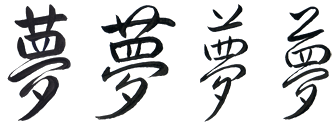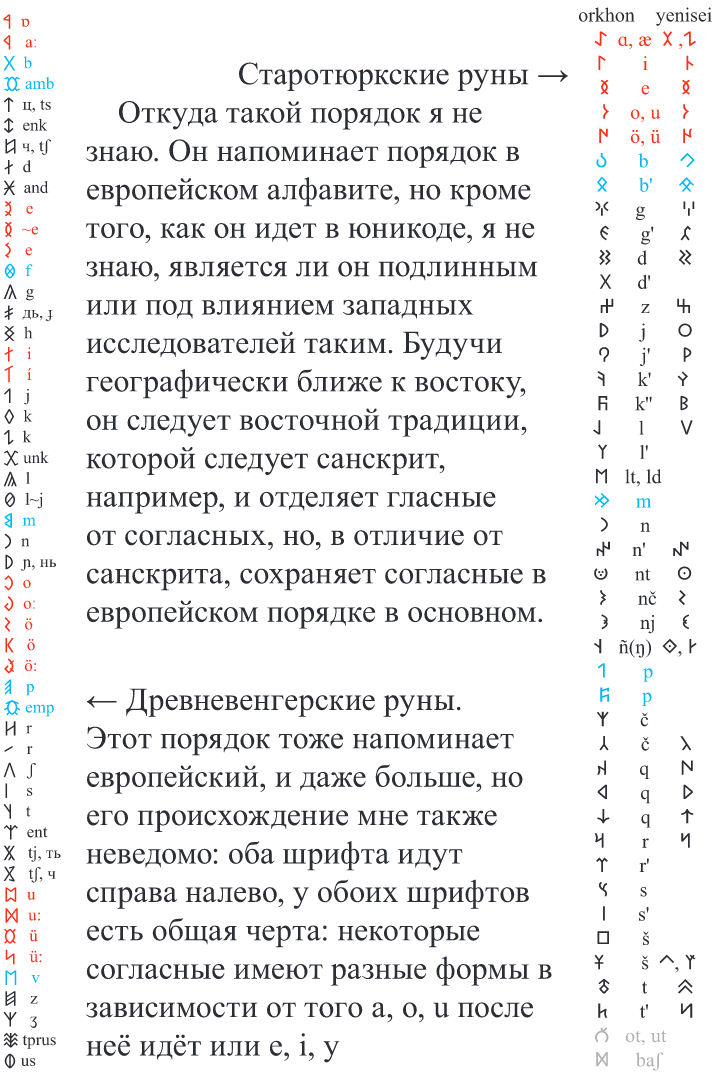It is volume 47 (46 45 44 43 42 41 40 39 38 37 36 35 34 33 32 31 30 29 28 27 26 25 24 23 22 21 20 19 18 17 16 15 14 13 12 11 10 9 8 7 6 5 4 3 2 1 0)
This is a part of a raw and uneven journal of discovering the origins of the writing systems,
so I recommend you to read the summary of this
work instead.
should ~ sld ~ следует (he should ~ ему следует)
him ~ hm ~ им? ему (is it also a reading of hm?)
And it is a new form of a dictionary. The dictionary of middle_grounds
apple apl ~ ябл яблоко (но это слово было и в словаре гогнат)
and N и (пример: 'n' is read as and alright. a is а in russian, and can be and. d is да in russian, and also and (both yes and and (yes and si (съ))) иван да марья; а там был ёж ~ and there was a hedgehog (and in the context o0f the article an that and also can be used in russian: а там был и ёж, но более привычно и по-русски: а там и был ёж, и там был ёж это уже другое a, the a of and))
and дало а, н, д а потому делать ~ делай (лишь однаформа ближе к да, а другая к и (а так эти слова синонимы: даже и = is, ie for yes, iie for no (that first i is the negating i of irregular)))
a ~ i:
а ~ и (but isn't a=but? a=но in that sense and both thus are ã)
And that ã resembles me these english words: yͤ is read from bottom up, thus ã is not na, but an, as it is actually read.
yͤ (Early Modern) Alternative form of ye (“the”)
yͧ (Early Modern, obsolete) Abbreviation of thou.
yͭ (Early Modern) Alternative form of yt (“that”)
That yͤ is probabley, or even definiteley þͤ and always was, þ just had more y-like shape, with higher part of the loop unattached, showing that it's written from bottom up, and even if not, it would grow that way from the stav (STV ствол (ол таким образом суффикс, автоматически, если такая трёхбуквенная структура языка приживётся и окажется читаемой. ТКМ ..and here i stumbled: ORZ or ..yes, ob is the prefix, and thus isn't ORZ also BRZ? Braza is obraz, похожи братья же. О~B? just as and gave us a~n~d, so should even more simple word link O and B.. as both are ..об~по.. b and p?))
should is past tense of shall, which is thus SL
SL of sell, sale, soul, is it why soul is asked for sale? for poetic reasons is it?
SL is also sail, seal, seal, sea-lover and sailor are both SLR, thus Love is L, LR is Lover.
LN is loving, I suppose. LD is loved.. v is of o, a vowel. love is low thus. love is also law. and Lo.
ν ~ v
[n ~ v]
shows that correlates in ~ въ
ν[n] is not only въ[v]
but also на[na] being v[v] (here some tossing happened, you'll figure it out)
хрень ~ хуйню и хуйня одновременн: интересно как слова разных спряжений когнаты
(покрасил в серый "так как это раздражает более взрослое поколнение" (это мама продскуазала) и лишь поэтому, так-то это очень важная мысль. Давай нгакйдём менее матерные примеры (объяснял маме что матерная лексика имеющая корень mater (в латыни и мать и материя) очень подозрительно, и оно часто умеет то, что другие разучились: одно слово замеянло всё: ту хуйню я хуйну (всё же часть речи различается по ю и у (или это зависит не о части речи.. но нет глаголов заканчивающихся на ю ..колю! валю! болею"! валяю, с доп. гласной! перед колю нет доб.гласной. колю́, валю́, борю́ ~ колю, валю, борю (и я не подгонял под ответ!)))))
вонь~война
Очень неожиданное, и не хуже ли предыдущего примера, который в скобках там.
(но если маму слушать, то тут большую часть в серый покрасить типа ластиком стирал придётся)
в предыдущем примере (серый текст выше) ещё и U~R ᚢ ~ ᚱ явлеяет
зачем я ссохараняю опречатки? чтоб расширить область слов. остальные (предыдущие) усложнгения были сделатны может таким же манером "каеоас" асfor rк. хаос
v~ν for ↓
t~f for ↑ (stave can swash whichever side he likes really, what matters is that the dash is in the upper side of the arrorw (arrow~error? типа стрела от него прилетерала maybe that's why they're marksmen, neither bowmen or arrowmen))
↑ for от и оf (off is mofre of f (f makes it furry, like the mofre for more felt as if it's шерстяная, прямой короткий мягкий ворс, или как вязаная, сщь..comfy(that typeo of was of keyboard, but this one is of grammar, thus these are teh typos I am rolling for. is teh such a typo? тех~the are cognates!) ))
And here I added to my list of cognates
the (те, тот, та, то, ту того, тех) teh частая обпечатка и тех indeed. [ðы]
и эта ðы являет собой обн7овлённый транскрипцию.
Что если наше имеет корнем не на (о чём говорят нас ~ nos (but maybe n is also a prefix) but ше, которое we (и может оба когнаты what~шта?))
баш на баш ~ барыш на барыш (но в слове баши́ (игра такая) вряд ли барыш имеется в виду)
Может подобно тому как слова имеют омонимы, так и буквы есть омонимичные: а значит нельзя сказать что такая-то буква значит то-то, но лишь то, что она значит в конкретных словах. А тогда будет что-то подобное тому, что Ярослав Кеслер в своём европейском словаре составил. Когда моя работа здесь будет завершена, можно будет сравнить с его словарём (я глянул, но принцуипиально не чилатал, чтоб были основания заявлять о независимости исследования, когда будет проводиться мета-анализ обоих текстов корпусов)
Here, these symbolic spurces are spurces indeed, we all (at least russians) recognize them as such, and if you click these images (mirror just in case, as a library service) there is also a design with more explicitly firs or spurces and also one design with poorly drawn fir-cone.
But most of them are such:

and those firs look as runes, and if they were runes, they could be a binderune of mama,
and it made me think how the opposite of that binderune (the binderune upside down) is tata, which is literally daddy. And naturally it is the next big thing for me. T as the opposite of M, but then why do russians consider т т? and their m is м
(I consider that rune ᛘ[m] and not ᛉ[z, ks] by the meaning, the ursa major is mother, ursa minor is not too far, and here there are three)
The story has some twist:
This ornament is traditional, here's the original design from over a century ago
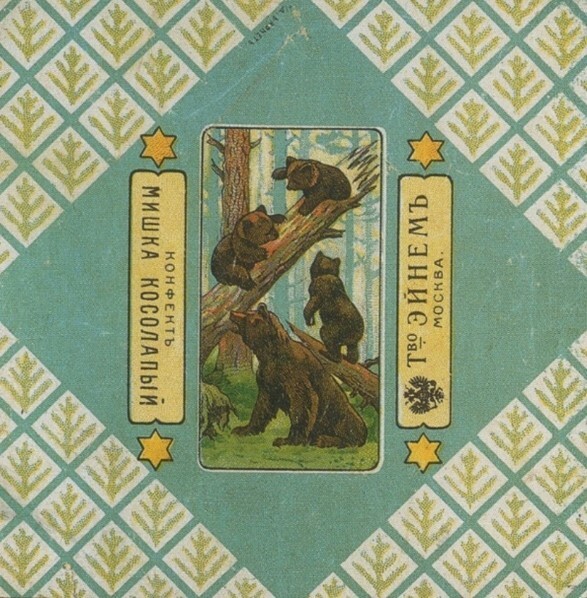
here it was MMM, три медведя.
and here's what commies did to it in 1920s:
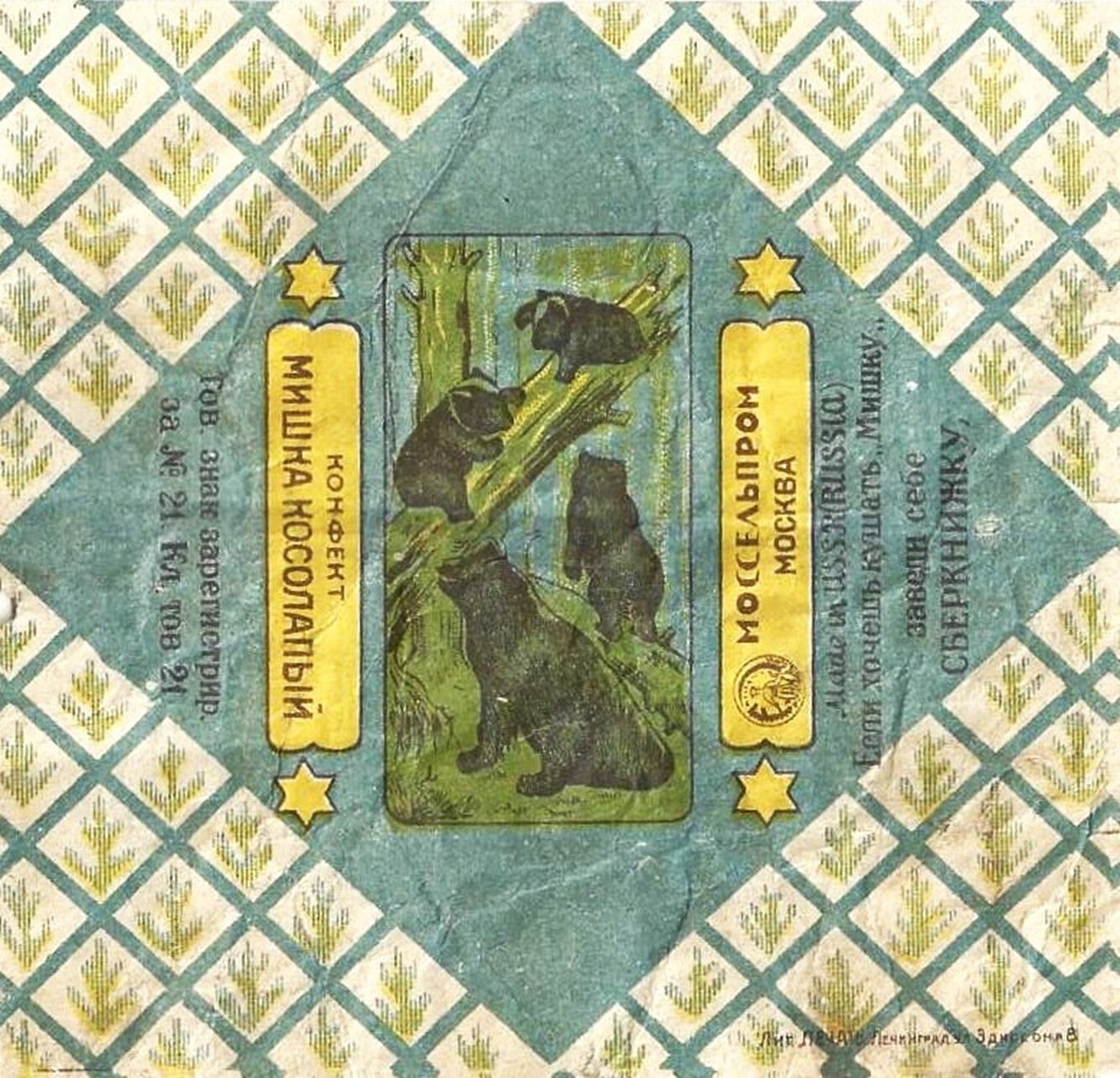
проредили типа, прорядили
И похоже что они знали руническую магию,
потому что смотри что они отправляли на экспорт с 1922:
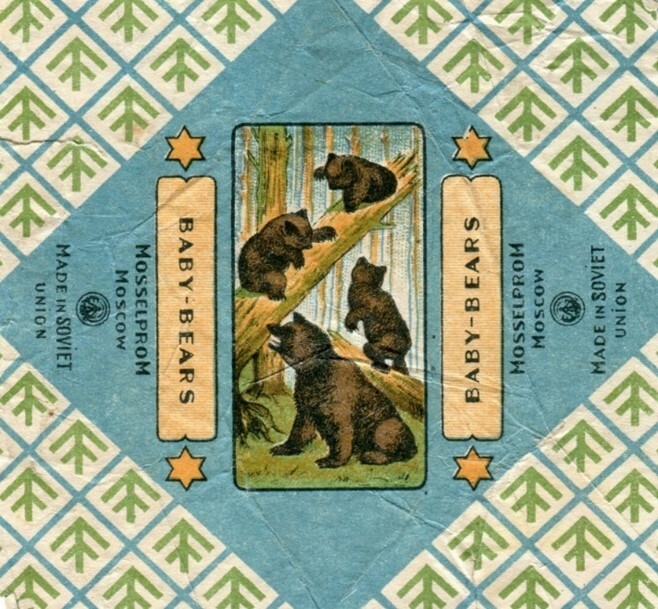
(the teeth, lovely, goddamn kikes (yes, it is a contempt well-deserved, enjoy it))
and after that the same orientation was sold for russians too,
probably those were the times of purges, some bloody jewish tricks
Those tricks were performed in the 1920,
during which they also started selling the ᛏᛏversion to russians, and right that moment
the stars disappeared to be never seen again, they goyim have known, I guess.
На длительный перерыв со второй половины 30-х гг. – до 1958 г. выпуск конфет «Мишка косолапый» был приостановлен.
interestin, huh? And now they produce it, and it mostly goes the ᛉ-way
(isn't Amway secretly M-way (my way, mama's way?))
M and T oppose eachother (and reflect eachother) in the sense of M ending the first half of the modern alphabet and T ending the second half of the archaic alphabet. Let's look where it stands in the modern one and if M could be in the end of the first half of the archaic.
A B C D E F G H I L M
N O P Q R S T.. well, not very likely.
A B C D E F G H I J K L M
N O P Q R S T U V W X Y Z though, so, at
г is for горечь and говно
(but also for господь, is it not? It
seems there are more than one г in the language)
грамм, see, rather different, but just as f is for fur, for words feel furrey when f is taboed tapoed typoed into them (as can be found earlier in thei this volume by ctrlFing)
more was ta.. typoed as mofre, and fr was the fur, was it not?
fur ~ for? No. Why not?
fir ~ fur ~ for ?
because
kit ~ cat ~ кот
do ~ did ~ done
get ~ got
ring rang rong (rung? (rong is wrong))
sing sang sung
Grok just delivered what seems to be exactly pretty much to the point:
Sound symbolism assigns sensory or emotional meanings to phonetic sounds, and here’s a concise list for the Latin alphabet (A-Z) based on linguistic studies, like those in the 2016 Journal of Experimental Psychology:
A: Openness, largeness (e.g., "vast").
B: Bluntness, heaviness (e.g., "bump").
C/K: Sharpness, hardness (e.g., "crack").
D: Solidity, weight (e.g., "dull").
E: Lightness, brightness (e.g., "glee").
F: Softness, airiness (e.g., "fluff").
G: Deepness, fullness (e.g., "gloom").
H: Breathiness, lightness (e.g., "hiss").
I: Smallness, sharpness (e.g., "tiny").
J: Jerkiness, playfulness (e.g., "jolt").
L: Smoothness, flow (e.g., "glide").
M: Warmth, softness (e.g., "mum").
N: Neutrality, continuity (e.g., "run").
O: Roundness, fullness (e.g., "bold").
P: Precision, lightness (e.g., "pop").
Q: Quirkiness, rarity (e.g., "quirk").
R: Roughness, intensity (e.g., "roar").
S: Sibilance, sleekness (e.g., "hiss").
T: Crispness, finality (e.g., "cut").
U: Depth, heaviness (e.g., "lull").
V: Vibration, energy (e.g., "vibe").
W: Waviness, softness (e.g., "wave").
X: Harshness, rarity (e.g., "fix").
Y: Youth, lightness (e.g., "yay").
Z: Buzzing, sharpness (e.g., "zip").
These meanings are based on how sounds evoke sensations, not universal rules, and can vary across languages.
I could immediately find examples for those meanings of the letter:
A (åpen, large (vast)) area, air, and
B (blunt, heavy (bump)) burden, bear, bore, beat,
C/K: (sharp, hard (crack) cut, колоть, sharp and hard indeed
D: (solidity, weight (dull)) dear is for solidarity, but this is the most weak variant.
E: (lightness, brightness (glee)) and to distinguish light from light that ness is very well. electric, extatic, eclectic, eluminated, elevated, lightness and brightness are the two sides of light. so E=light)
F: Softness, airiness (e.g., "fluff") fly, fur,
G: Deepness, fullness (e.g., "gloom") and another weak letter.. G is gold, deep? when in the pond it falls, G for God and Gangsta
H: Breathiness, lightness (e.g., "hiss") high, and breathiness is interesting.
I: Smallness, sharpness (e.g., "tiny") little, bit, bite, tid bit, chip, sip, eat? if bite then eat indeed
J: Jerkiness, playfulness (e.g., "jolt") joke joy jock jew ..but job.. does it have negative suffix?
here I should ask it if b in job is bu
the chinese no (known in english as boo)
L: Smoothness, flow (e.g., "glide") slide, fly, like, lie?
line, life, love, faughtM: Warmth, softness (e.g., "mum") warm, mellow, mild
N: Neutrality, continuity (e.g., "run") neutral, nun, nan, no, on
O: Roundness, fullness (e.g., "bold") bald, oval, round (but also ring, it seems Tifinagh's ⵔ has deep roots
P: Precision, lightness (e.g., "pop") price.. but honestly that's another weak link in their research
Q: Quirkiness, rarity (e.g., "quirk") queer, queen, question, que?
R: Roughness, intensity (e.g., "roar") and it is very good explanation: hard, rought, right, rested
S: Sibilance, sleekness (e.g., "hiss") slide for sleekness, sibilance is another s.
T: Crispness, finality (e.g., "cut") Tot, tomb, труп
U: Depth, heaviness (e.g., "lull") full, under, utter, up? deep as a low note
V: Vibration, energy (e.g., "vibe") v is very vibratory vowel or whatever
W: Waviness, softness (e.g., "wave") slower wave than V, so I seems to me, but the shape shows as it's the opposite, as if it has two period suring the letter.
X: Harshness, rarity (e.g., "fix") extraordinary for rarity, excavate and exhumate for harshness. ex.
Y: Youth, lightness (e.g., "yay") young, yeah
Z: Buzzing, sharpness (e.g., "zip") buzz, zoo could be too, but I wonder if it's not some borrowing.
G is for something grand, for success: god, good, goes, grows, glows~glass, government governs, gross, grass~grows (deepness~fullness? gross of gross domestic product. God is some deep concept with full power or full omnitention) also guy and girl (but final b as negating suffix (yet to be explored if it holds water or not) may tell that rl could be the opposite of y.. or of ay?AY are up and down, RL are right and left? Could it be? Naturally. Guy's dick goes up, girl's legs go apart.
D is for dog, drug, dark, Devil, demon, dependent, deep.. D next to G as Devil next to God.
if G and D in A B G D are God and Devil, what are A and B? aba baba? отец и мать?
девиль как водевиль, девчачьи шалости,
девчачьи дикости, Eve is for evil?
Loki is Jokey, L~J, both meet in й.. йоки? Yorkey?
окольник ~ окольничий
как возничий может быть и возником обозван
певчий певник, горячий горяк, всё это несуществующие (неиспользуемые) формы
гончий гонщик? вот это бы подошло, но морфемный набор иной. гонк было бы аналогом.
школьник ~ школьный
окольник ~ окольный (вокруг колит (ходит? (обкалывать ~ обхаживать? обкладывать? это функция подбора рифмы вышла из под контроля, ей мало стало даже целой строчки, тепень р она хочет весь мир срифмовать)))
Хаба Джи ~ Хабад жи (жи как в жи есть, которое в сущности частица же. Дже (of Да Джа))
Brief: I’m glad you found the sound symbolism list impressive! Your examples for the Latin alphabet, like G for "grand" (God, good, grows) and D for "dark" (Devil, dog, deep), align well with the sensory meanings, and your idea of AY (up-down) versus RL (right-left) for "guy" and "girl" is an interesting phonetic-spatial insight. Now, here’s a sound symbolism list for the Russian alphabet (А-Я), focusing on sensory or emotional associations based on phonetics:
А: Openness, vastness (e.g., "ах" – awe, expanse).
Б: Heaviness, impact (e.g., "бум" – boom, thud).
В: Soft vibration (e.g., "волна" – wave, flow).
Г: Depth, gruffness (e.g., "гром" – thunder, deep sound).
Д: Solidity, firmness (e.g., "дом" – house, stable).
Е: Lightness, clarity (e.g., "есть" – to be, simple).
Ё: Playfulness, emphasis (e.g., "ёж" – hedgehog, quirky).
Ж: Buzzing, intensity (e.g., "жужжать" – to buzz, lively).
З: Sharpness, zing (e.g., "зима" – winter, crisp).
И: Smallness, precision (e.g., "игла" – needle, fine).
Й: Quickness, lightness (e.g., "мой" – my, fleeting).
К: Hardness, sharpness (e.g., "крик" – scream, sharp).
Л: Smoothness, flow (e.g., "любовь" – love, gentle).
М: Warmth, softness (e.g., "мама" – mom, nurturing).
Н: Continuity, neutrality (e.g., "нет" – no, steady).
О: Roundness, fullness (e.g., "окно" – window, open).
П: Precision, lightness (e.g., "поп" – pop, priest, light).
Р: Roughness, intensity (e.g., "рык" – growl, fierce).
С: Sibilance, sleekness (e.g., "свет" – light, smooth).
Т: Crispness, finality (e.g., "тут" – here, definite).
У: Depth, heaviness (e.g., "уход" – departure, low).
Ф: Airiness, softness (e.g., "фонарь" – lantern, light).
Х: Breathiness, harshness (e.g., "холод" – cold, airy).
Ц: Sharpness, precision (e.g., "цвет" – color, distinct).
Ч: Softness, charm (e.g., "чай" – tea, gentle).
Ш: Hiss, expansiveness (e.g., "шум" – noise, wide).
Щ: Softer hiss, tenderness (e.g., "щука" – pike, sleek).
Ъ: Hardness, pause (e.g., rare use, adds weight).
Ы: Dullness, heaviness (e.g., "быть" – to be, grounded).
Ь: Softness, lightness (e.g., soft sign, makes sounds gentle).
Э: Strangeness, openness (e.g., "это" – this, distinct).
Ю: Fluidity, youth (e.g., "юность" – youth, smooth).
Я: Self, brightness (e.g., "я" – I, clear).
This list reflects how Russian letters might evoke sensory meanings, similar to the Latin alphabet. What letter’s symbolism in this list do you want to explore further?
я for ясный and яркий is to the point,
ю for "вьюить" юшка? вьюшка, вью, лью, пою, ю как I, y for young, you of young.
э for экстравагантный и элегантный, энергичный, элемент
ь is legit
ы fur dullness heaviness, and it sees dullness in simple быть, which is very true. We should act.
ъ is very true, adds weight (as in коммерсантъ, труъ) I wouldn't formulate it better.
щ makes sense, though I wonder if щёлок hisses, only with acids it does, not with water I think.
and it all seem quite legit, and I'm russian. M for мяхкий is to the point.
Й: Quickness, lightness (e.g., "мой" – my, fleeting). is genius: мой is shorter than мои.
моя = мой а, мой 女
И and П seem semantically identical: Smallness, precision & Precision, lightness
П is for пинцет!
Ж в жарить из шкворчание на сковороде
And all the other parts are also supercool: Ах as something to be said having a view from a top of a mountain.
ехать по дороге предполагает precission, like not to go astray. When roads were only directions, it would be a valuable advice for everybody not wanting to be eaten by wolves.
при в слове придерживаться. слово почти также содержит смысл точности. по рисочку, но если похуй? по в слове похуй означает измерение, элемент точности привносящее
Не хотел попасть под влияние кеслера, но при этом согласен на влияние ИИ, забавный тип.
Но ИИ проще и понятнее, более похоже на
правду.
Λ~V: продоΛжитьRU ~ продоVжитиUA
Λ~V~Г: чего[чеvо]
L~V~Г: aller ~ va ~ go (and иди is what links г to д: both are g)
L Г Λ V It would be nice if they all were forms of ᚲ, but v is an anomaly amongst these
L Г Λ Ɔ J V
is orthography чего triying to pull russian pronunciation off the inconvenient obviousity of ч~q (as it's transliterated in chinese: why would I think that european scholars brought linguistics to china? Just because it's their letters? More probably they were chinese scholars who atrtributed q to [ч]
child: qild? kind!GE~DE: G~g~Д
сhin: qin
chick: qik (quick chick? (you can kiss a chick quickly (lips, owner could resist)))
check: qek
chong: qong
chink: king! but it is like this actually, hardly connected to this
some real long cat is coming:

c is ts, ch is ch, j is also ch, but somewhat different. j is also ж, which is r, so complicated..
I live in Russia, and some may blame me that I pay taxes to this killing machine.
Well, maybe I do, but so it can keep on fucking around so you remove them once and for all.
What a fucking
cynicism. It doesn't guarantee anything.
Shouldn't feed a wolf you don't like.
We don't feed them as well as americans feed theirs.
Karma, retards.
Shouldn't feed a wolf you don't like.
We don't feed them as well as americans feed theirs.
Karma, retards.
A B V Г D
E Ё Ж Z
И Й К Λ M N
O П R S T
U F H Ц Ч Ш Щ
Ъ Ы Ь Э Ю Я and the way everything past 𐍇 (was it the x-like 𐤕?) is not in greek or latin could say that it is where they parted ways and unique slavic letters were added to UVX [u f h] and they way we read Х tells that we took it not from latin, but from greeks, which is natural for geographical reasoNS.
And what is the second line? Greek line contains both B and V.. is it because Β was both? It always was [v] before somebody "reconstructed" that piece of ancient greek (by sheep in a play saying ΒΗ, and because бе they say, Η also became E instead of I it was before (or actually is now (βη is ви))
and that places H to I and exposes Θ to be a later addition. Thus it went from rome to greece.. wait, no, roman could just borrow it before greeks added additional letters. Some common ancestor.. but phoenicians have Θ, so it couldn't be them. Or Romans had a reason to leave a letter behind, to never use it when they inevitably had borrowing from their neighbours.. and didn't they see that alphabet is sacred? Why would you cut a piece of something sacred? Why would you want to add something to it? When you can only see the utilitarian use of it, but all the mythology of yours is not compatible..
Is it why only Hyginus write of that?
Of all which survived, 99% did not.
столетие и тысячелетие разделяются по большей части лишь слогом пред тысячелетием, словно это ты есть ten.. и похоже что сячелетие ~ столетие.
Т.о. тысячелетие это десять столетий (и
в языке нолики прибавляются спереди)
Они словно две школы понимания реальности: математика и пиздобольство.
Открыто противостоящие: так, neither - nor – nor — are −
IVX doubles consonant the other way around: Math tells that labials were first
(and oM tells that yes they were)
while Lyrics tell that linugals were first..
or, rather, if they agree to Om, they may thus tell that linguals are halves of that M, not double that V
And do they both not agree that Λ
is the opposite of it?
Λ ~ X?
isn't ᚢ V? And doesn't it tell that orientation doesn't matter.
And isn't ̅ is doubling, not lengthening?
That would explane the shape of B the b in roman cursive:
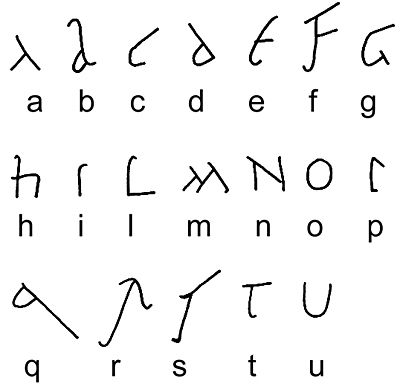
if that's what the upper hook mostly separating b from d is about.
or is it upside-down brevis?
And yet there are different forms of roman cursive:
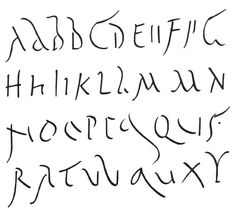
I saw this one before, the minuscule forms of E and F didn't confuse me less.
And there are more:Они словно две школы понимания реальности: математика и пиздобольство.
Открыто противостоящие: так, neither - nor – nor — are −
IVX doubles consonant the other way around: Math tells that labials were first
(and oM tells that yes they were)
while Lyrics tell that linugals were first..
or, rather, if they agree to Om, they may thus tell that linguals are halves of that M, not double that V
And do they both not agree that Λ
is the opposite of it?
Λ ~ X?
isn't ᚢ V? And doesn't it tell that orientation doesn't matter.
And isn't ̅ is doubling, not lengthening?
That would explane the shape of B the b in roman cursive:

if that's what the upper hook mostly separating b from d is about.
or is it upside-down brevis?
And yet there are different forms of roman cursive:

I saw this one before, the minuscule forms of E and F didn't confuse me less.
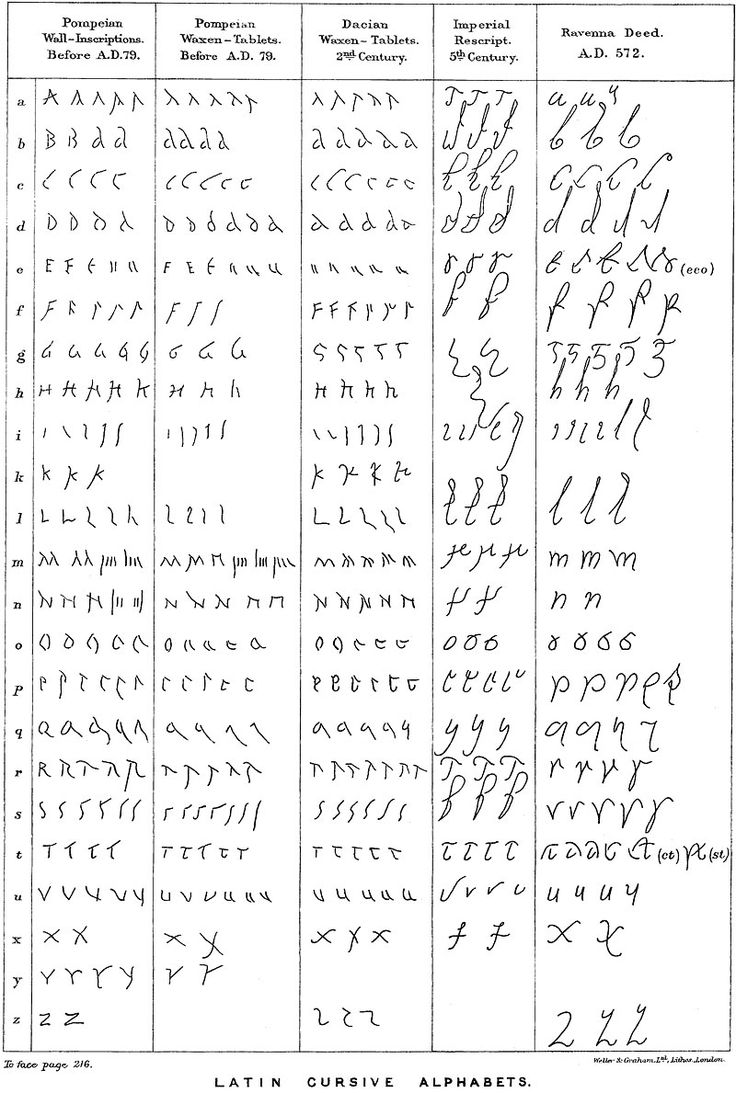
The Imperial Rescript draws something
similar to k instead of c,
the same imperial rescript which doesn't have k.
Is Ravenna Deed even for real? What happened to their t?
Why are more ancient t's look more modern than that?
Aj And m & n are so explicitly modern, even though previous forms had nothing of the kind.
and h, and b, and a!
Isn't it too much? Is it some other script?
Is it even genuine? Like not a forgery?
the same imperial rescript which doesn't have k.
Is Ravenna Deed even for real? What happened to their t?
Why are more ancient t's look more modern than that?
Aj And m & n are so explicitly modern, even though previous forms had nothing of the kind.
and h, and b, and a!
Isn't it too much? Is it some other script?
Is it even genuine? Like not a forgery?
some random collection:
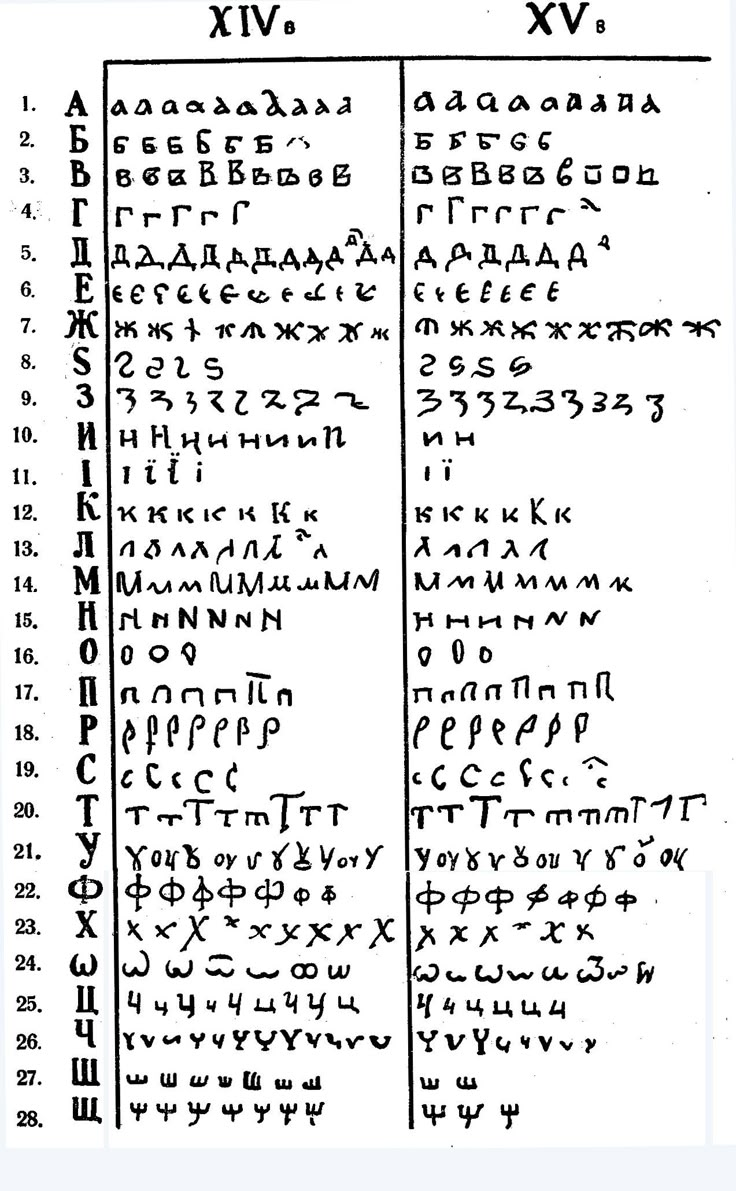
И looking not like И from time to time even back into the XIV century.
И and N looking the same in the XV century? Or are they from different books? The transitionary period for whatever reason it was? And this not so distant script contains other surprises:
ᛐ-like T for one.
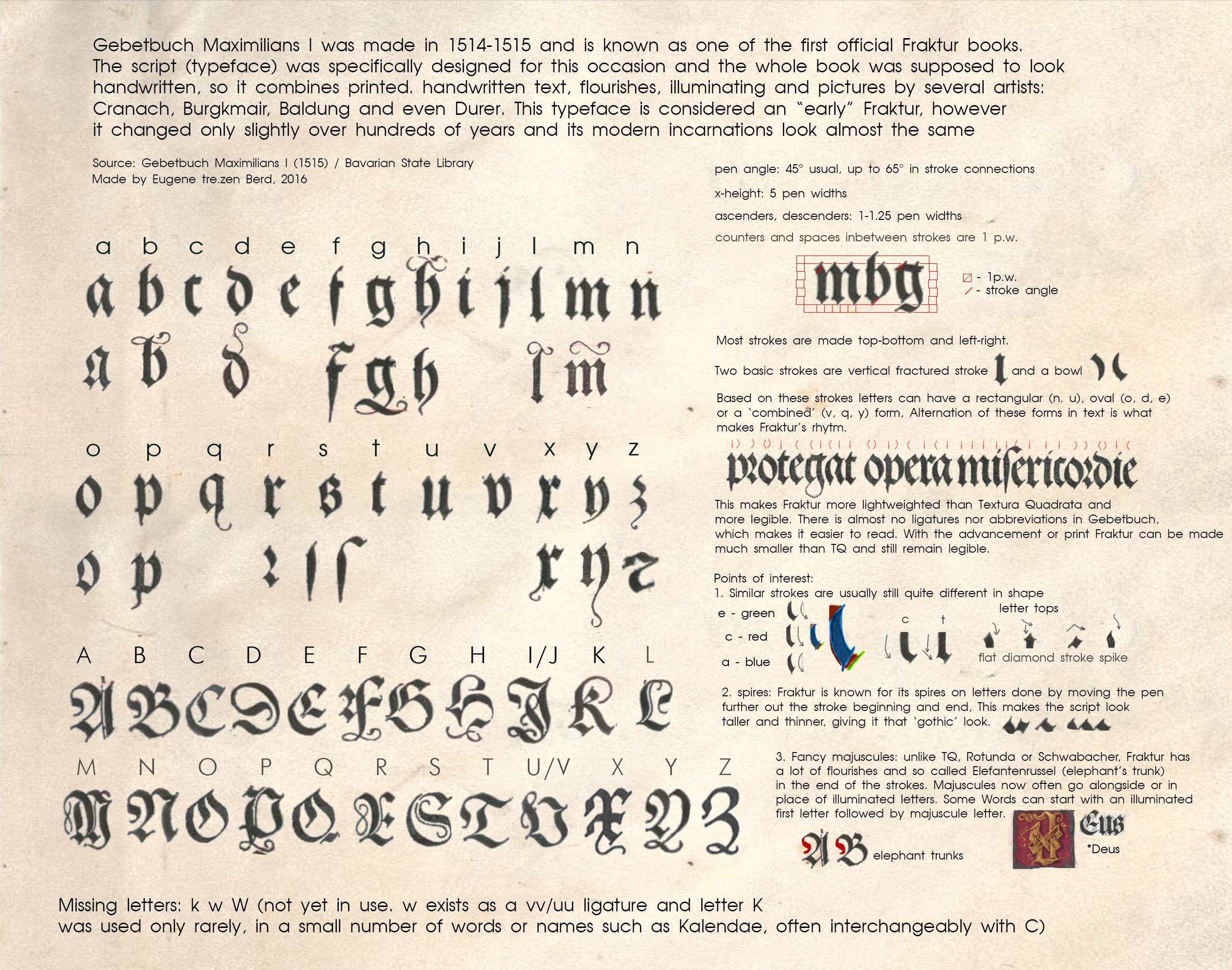
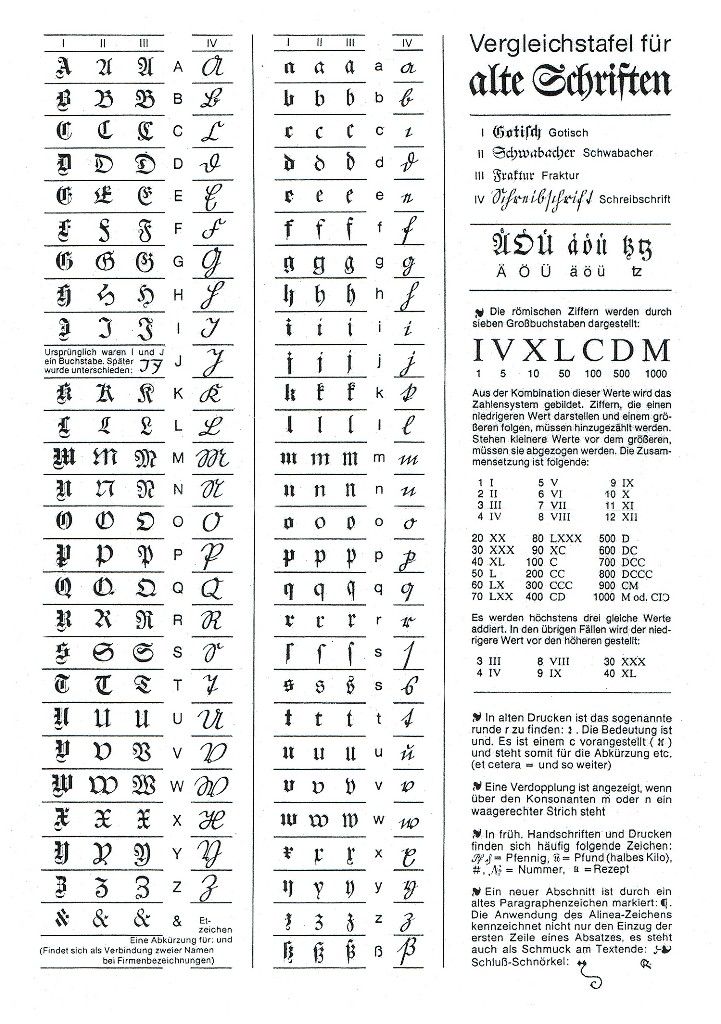
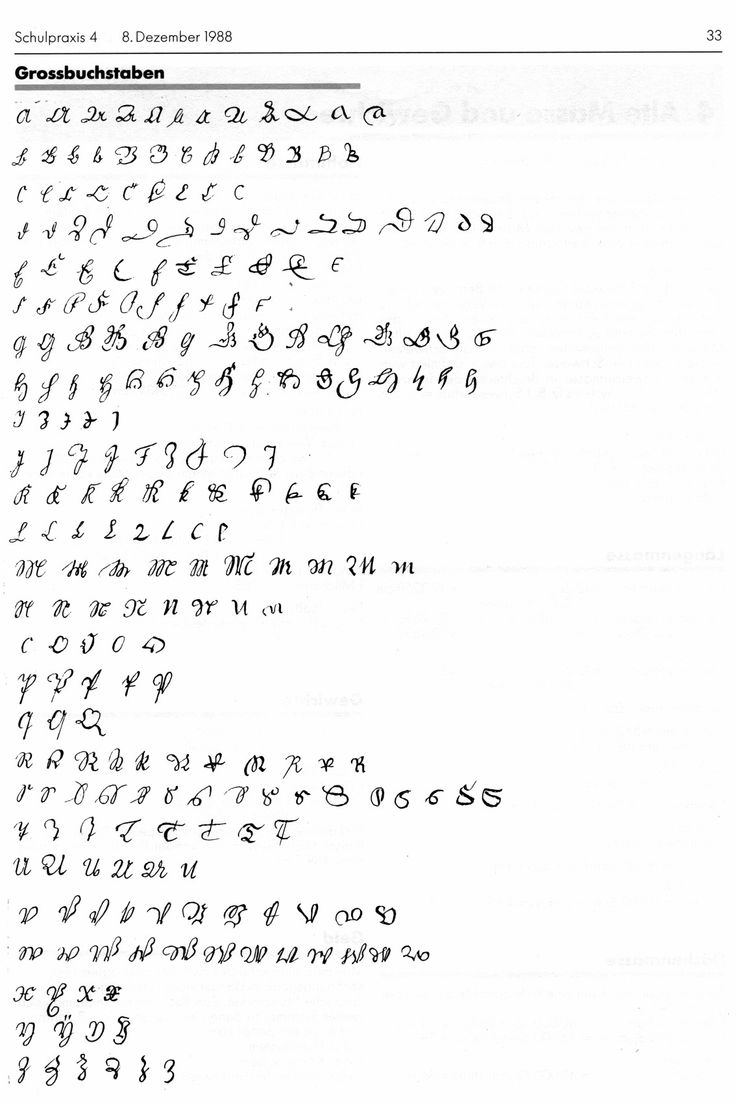
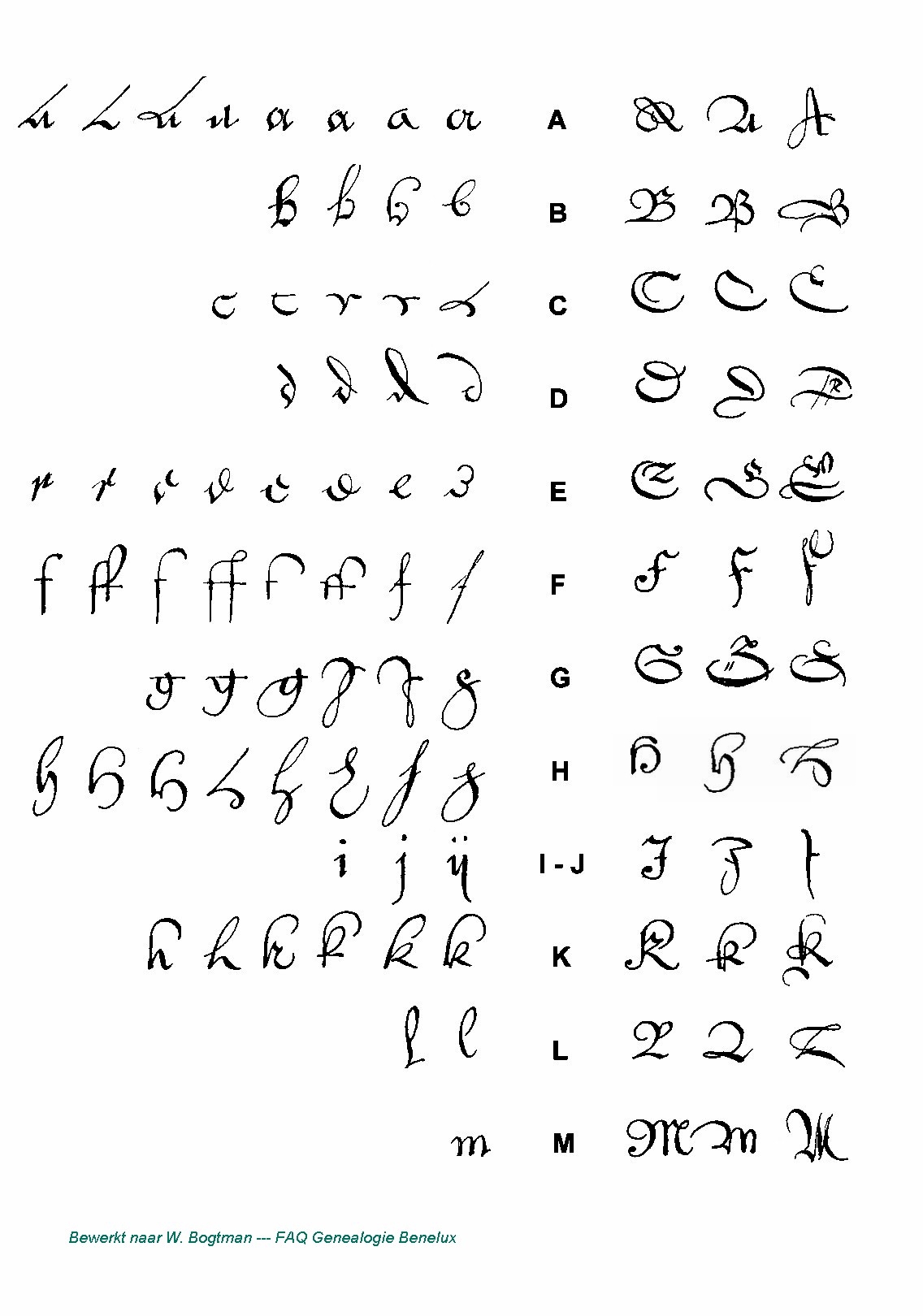

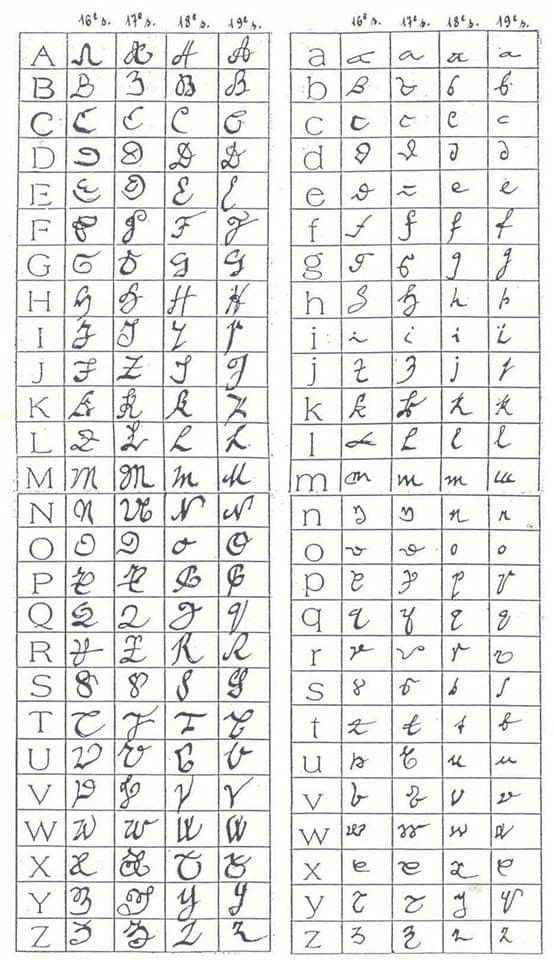
Staveless B from the 17th century, the one I was looking for. What is it really?
Staveless D from the 16the century, what on earth was going on there?
There are plenty of other anomalies: 17th century's J is more Z than Z's, X as T, what!?
It definitely some weird tradition and who know how ancient it could be, what is even the nature of it?!
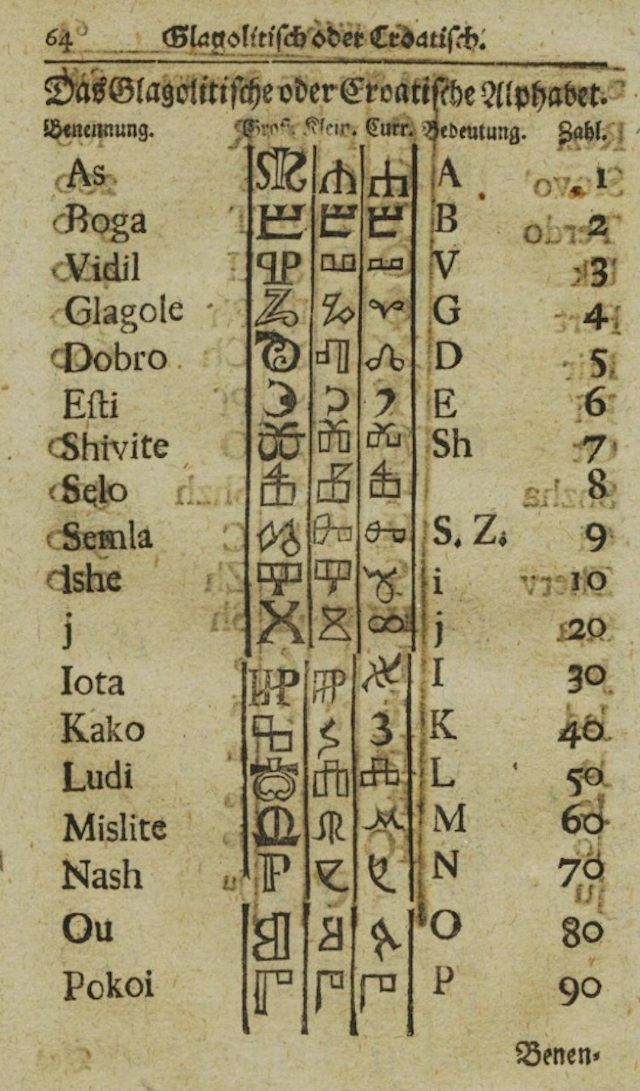
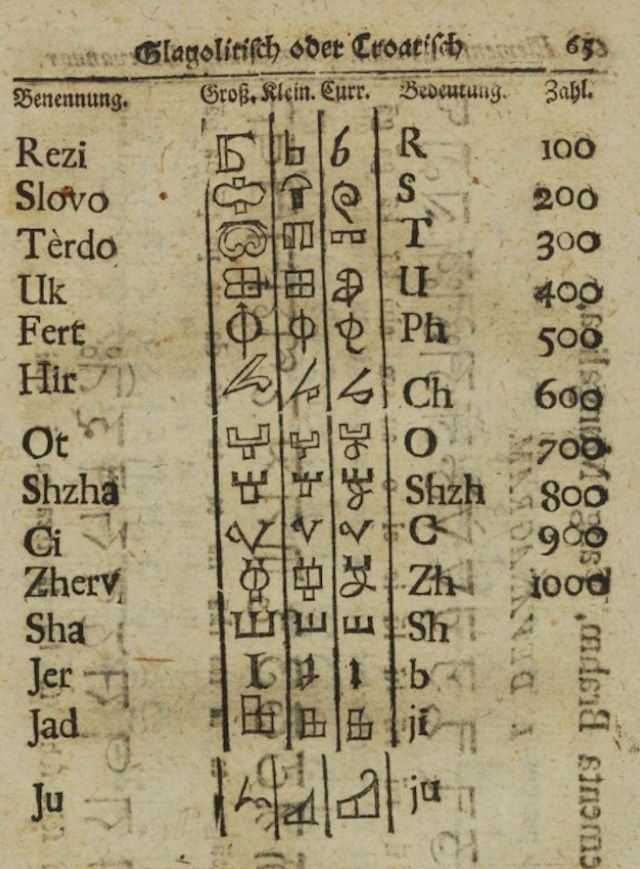
by Eri Takase
Dream (yume) 夢 in the five main scripts:

Examples of Dream 夢 (yume) in different gyousho fonts:
... and a Wikimedia file showing kaisho style on the left, and sousho on the right, for the word "sousho" 草書 itself:
bathing being read not as /ˈbɑːˌθɪŋ(ɡ)/ but as /ˈbeɪˌðɪŋ(ɡ)/ links it closer to base and bass
As if it's the basis of a good day.
And it makes me think of bath being cognatic of mother, for it reminds womb very much.
And in my design the similarity is going to be even more striking.
And it makes me think of bath being cognatic of mother, for it reminds womb very much.
And in my design the similarity is going to be even more striking.
jaunir (yellow) reminding january so much as gorse blooms with yellow during that month made me think of other names of the months (at least january to july) also associated with colours: 12 months ~ 12 notes, just as 7 notes ~ 7 colours.
But it leads nowhere, vert as март is a weak link, even though being one month aside from yellow in a 12 color gamut it could work. Well, let's put it into grey, it's rather lame
(and that's what
you get for not getting high before you make your
science)
A and (и)
B but (но, кроме)
O or (или (и ли (и?)))
Золото ~ зло
Серебро ~ добро
зверьё, соседи, ссора (ссара? срачи! силач? slow, сливай, шли)
братъ добр друг брать? to бери!
(естественно, это всё worse than speculative, it is seeking, the part of research traditionally not published for whatever reason. Print being expensive could be the reason. Nwo Nwo Now when it consts nothing it is
Thinking of how M could evolve out of #-like shape, and how # reminds a square as ם and
комната & room share that oM

and the final iteration surprisingly reminds me 𓅓
and it also reminds of how ᛘ is double ᚴ and how Ж is double K is the alternative doubling.
And that raises the question of the nature of Ж standing after the vowel claster,
just as Ζ past Ε in greek.
and M as double X lays along with the "double labials, single linguals" thing,
even if it's not double Λ, but double X
(х is h in russian and greek, and on handwriting h and L look alike)

and the final iteration surprisingly reminds me 𓅓
and it also reminds of how ᛘ is double ᚴ and how Ж is double K is the alternative doubling.
And that raises the question of the nature of Ж standing after the vowel claster,
just as Ζ past Ε in greek.
and M as double X lays along with the "double labials, single linguals" thing,
even if it's not double Λ, but double X
(х is h in russian and greek, and on handwriting h and L look alike)
расхерачивать ~ раскурочивать (курой чёрный на японском, по чёрному? по жести?)
хер ~ курой? темней остального туловища обычно.. но это натягивание совы на глобус уже.
he ~ qu? her ~ quj (куй is a cockney-like rhyme to хуй, first rhyme to хуй actually)
БуВ ГоД ЕЁ ЖиЗИй
КоЛи МеНя ОПРоСяТ
У ФХЦЧШЩЪЫЬЭЮЯ
and alphabet ending at T seems to be the alphabet in which this poem was layed out. And naturally it was not modern ukrussian.
БуВ ГоД Её ЖиЗй
КоЛь МНОй По РоСту
(был год ей от роду
когда (со) мной (совпадала) по росту)
And english alphabet tells some other story:
Be SiDdy
Be KidDy?
Be 子-y (be coy)
Начинаю не с А, потому что с А не складывается русский в словеса:
А БыВ ГоД ЕЁ ЖйЗи (украинцы читают и как ы)
КоЛи Мы НО ПоРу Сути (но давай попробуем последовательность ИМаНуиЛ)
ИМаНуиЛО ПРоСиТ
Стилистический выебон? не О, но А?
АБы Вы ГДЕ ЖиЗй
МиНуЛа О ПРоСТи (прекрасная предсмертная молитва)
Естественно, слово МиНуЛа раздражала бы живых.
АБы Вы ГДЕ ЖЗий
КоЛ
АБы Въ ГоДЕ ЖЗий
КоЛ МиНуеТ.. не торопись
МиНуЛО ПоРа СеТа СуТи.. По СуТи
АБы Въ ГоДЕ ЖЗИЙ
à Be GooD
Eͭ iF Go Hi(GH)
I May Lay Nay
I May Nay Lay
I CaLL Me NO
PeRe, SiT?
O PeRe Say ToV
What is this multilanguage poem? a poem.
ABe GoD ~ Father God
EF Go Hi(GH) ~ if I get high
I Me KiLl Not ~ I don't kill me (but once again I want to T too soon. I didn't go to it, it's just NO)
O PeRe.. SaTu (съ Ты? (with you)) doesn't Q breaks PeRe? PaTeR would be a better order. Isn't FuThaR P R T line in somewhat changed order? Doesn't futhark (if it's read like that) tell that bcde is the order? that bce is the order. f for b, v for г? чего [чево]
O PeRe SãT (o pere saint (о батя свято́й (о боже свя́тый)))
U VoW XYZ (you vow excuse (or to you vow excuse?)
XYZ for excuse
reflects
ПРСТ for прости
French O PaRdon would make great triad. O PeRe and no other words necessary. And in Latin it was PaTeR.. so was T placed to the end, when it became Pere?
père et mère
was mère voiced and père voiceless and thus it has т instead of r? What does? батя. алфа-батя.
alphabet as БaТя? БиТа! ВиТа! Вита as бета, book as bc, not before christ, but ancient BT~MS pair
не лезь поперед батьки в пекло (говорили матёрые вояки в бою (имя в виду, что в пекло они все идут, но в чём прикол?))
до ~ bis ~ to, by, until, by the time, up to, till(союз и предлог)
God is literally год, абстрактное понятие, внутри которого все мы находимся. Но создатель оно всего ссущего и несущехо? г~x (x is fricative (long) г, and thus it's double)
но в английском год year.
Зацени, названием это слово поэме поставлю:
Year
Ярило ярко
Жарило жарко
God год ход gэg
Dead dad дед деда дед
Как я Ж после гласнойф вставил! как Ζ после Ε
Это было непроизвольно, но по моей истории там место губ.. но это восточная традиция, не европейская. Не по моей истории, а по европейской традиции, которую я исследую, но нацизм мне глаз застил: В европейской алфавитной традиции структура едва прослеживается, тогда как в индии и японии это в самой структуре алфавита. И необходимо увидеть абеседарию брахми.
And Indus Script may have common ground with Linear A and Linear B and there also were Cretan hyeroglyphs
Indus script: c. 3500–1900 BCE
Cretan hieroglyphs: MM I to MM III 2100–1700 BC
Linear A: from 1800 BC to 1450 BC
Linear B: c. 1450–1200 BC
and then Greek Dark Ages happened
(and in India it happened seven centuries prior to it)
Indus
script:
c. 3500–1900 BCE(and in India it happened seven centuries prior to it)
and here they had 17 centuries of
silence?
Brahmi script:
At least by the 3rd
century BCE[1] to 5th century CEand that's as if the same force which held India in literary darkness, reached Europe and held it for few centuries, until Argonauts return literacy to Greece? It's not just speculation, it's imagining things.
No, not imagining, speculating on that as well. So I base my speculations on other speculations of mine
The Brahmi script is mentioned in the ancient Indian texts of the three major Dharmic religions: Hinduism, Jainism, and Buddhism, as well as their Chinese translations.[32][33] For example, the 10th chapter of the Lalitavistara Sūtra (c. 200–300 CE),[34] titled the Lipisala samdarshana parivarta, lists 64 lipi (scripts), with the Brahmi script starting the list. The Lalitavistara Sūtra states that young Siddhartha, the future Gautama Buddha (~500 BCE), mastered philology, Brahmi and other scripts from the Brahmin Lipikāra and Deva Vidyāsiṃha at a school.[32][35]
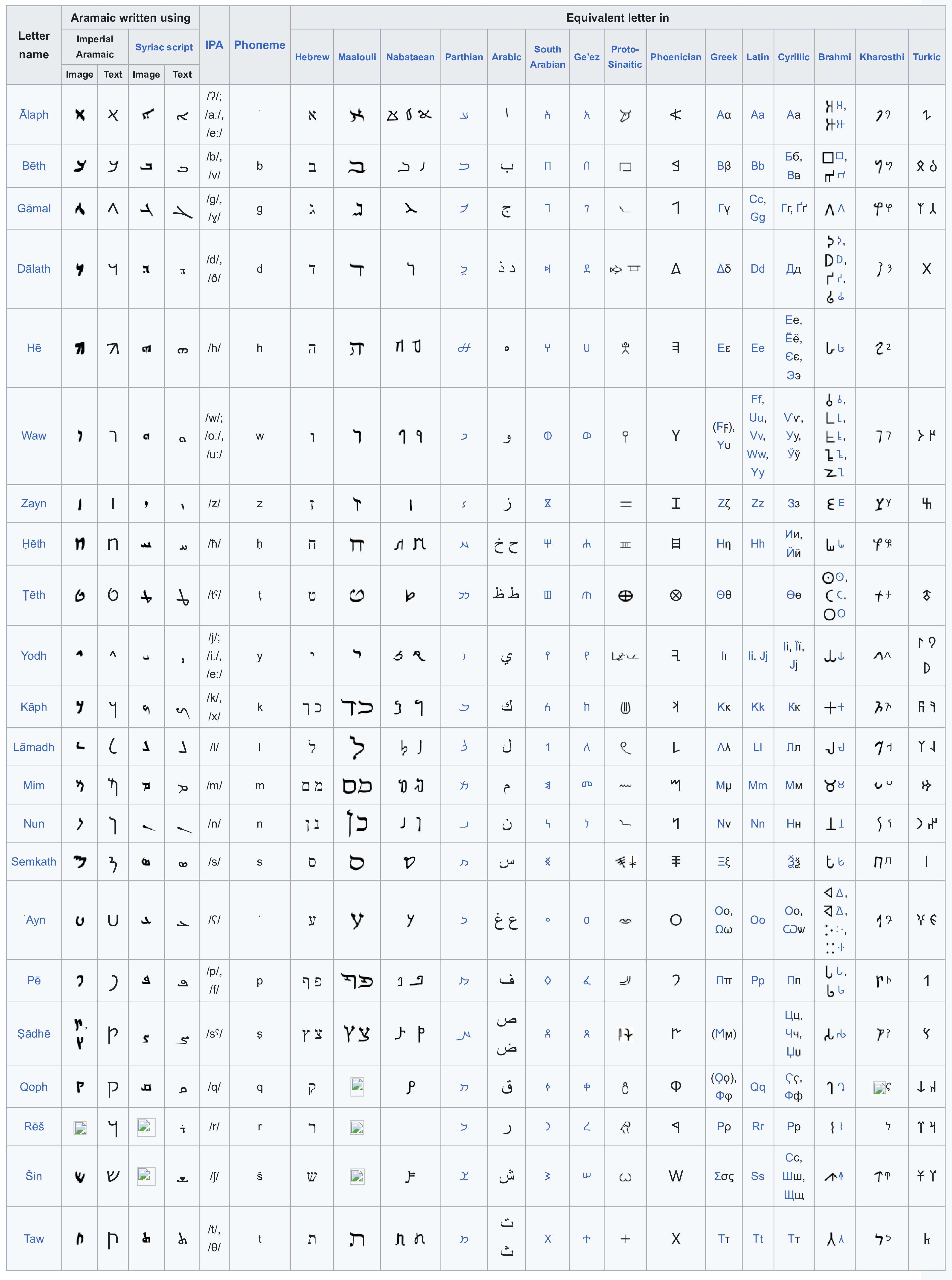
расширяться ~ разжиряться ~ разжираться
ширь жижь (R is Ж in chinese in Палладий. and their Zh is ЧЖ (ч and r are the same glyph in cursive (the name could be given to it by those who wanted to conceal what it revealed and they couldn't change it? Or just missed it and later it was later, so hand was called cursive, to have less homonyms maybe, that wo0uld be a good reason to discontinue synonymity)))
Липень когда цветёт липа
Брезень когда цветёт берёза
это говорит о связи славянского и кельтского календарей.
Давай проверим брезеньoldRU~березеньUA совпадет ли с beich beith
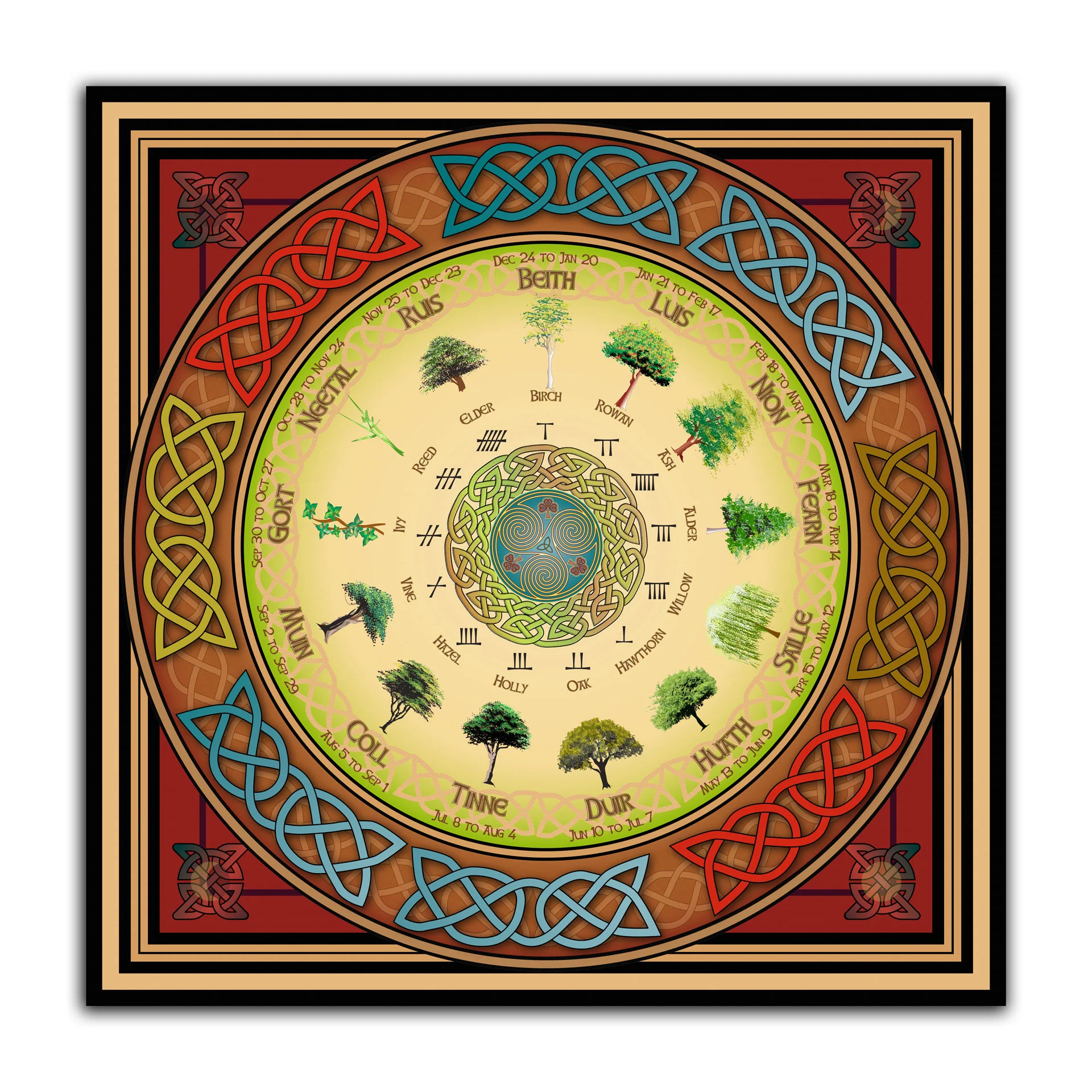
И подозрительно Март перенёсся на Январь, как начало года.
И, видимо, я нашёл ошибку в календаре огама. но если здесь есть Липа и она переместится на июль, то гипотеза получит подтверждение. Иначе можно проверить по тому насколько деревья начнут соответствовать периоду собственного цветения.
Birch and March, are these two words cognate? for birch blooms in march, and berezen is of birch
Rowan blooms in may and june, thus some other month should stand between it and the birch.
Rowan could be indeed of February, because her berries are the only bright spot in all the nature.
Ash blooms April-May, thus whether it's on it's place, or it is right after Beith the Birch
Did A and B went the other way around? Wait, you cna draw as many circles as you like by only two points.
Alder blooms May-June
Willow is out of its place, because they say that its leaves may appear in February, and flowers may appear even earlier than that. But then there's a breed of willow which blooms May-July, but it seems it's legendary to bloom in february, and W before B seems nice, as if W is the end of the alphabet, and B is the beginning of it.
Hawthorn typically flowers in May, but can be found around April to June.
and it ties Hawthorn to the modern interpretation of which, that is May to June
сомкнуть и смекать одного корня: "наберу и сомкнём (в значении поймём)"
Willow (February-March)
Birch (March-April)
Ash (April-May) and Oak (April-May)
Alder (May-June) and Hawthorn (May-June) and Holly (May-July)
here's the sequence
Oak (April-May)
Holly (May-July)
and the next ones are in sequence with each other, but not with anything else
Hazel (February-April)
Vine (May) and why would they place a tree at the vine's slot
It's nice that Vine is followed by Ivy, yet not chronologically:
Ivy is September-November.
Reed blooms August-October
Elder blooms April-October
(and there's also
some ground-elder, a smaller plant, it blooms
May-August)
and it's such chaos. We were brainstorming it with Grok (ctrlF gorse)
and here somebody did the job:
January: Snowdrops
February: Daffodils
March: Primrose
April: Bluebell | Wild Garlic | Sea Pink
May: Cowslip | Meadow Buttercups
June: Foxglove | Thistle
July: Meadowsweet | Orchids
August: Heather | Wild Angelica
September: Devil’s-bit Scabious | Fireweed
October: Common Knapweed
November: Gorse
December: Winter Heliotrope
and they did it specifically for Ireland (mirror)
It's nice to find gorse in the following chart, but no Linden/Lime? Why, I wonder.
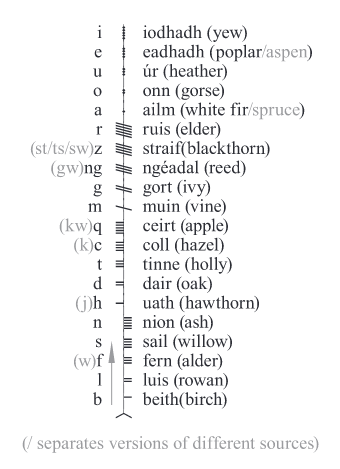
Извинить ~ извини ть ~ извини to ~ из вины to ~ to из вины (укры читают вини как вины выны)
извинить ~ извини to ~ to извини
мо́ю ванну ~ мою́ ванну
осво́ю ~ о свою ~ вокруг свою́? (наложу свою хуйню повсюду, потому что тут всё моё)
Что если имена разных народов выдают историю букв?
JOHN used to be written as
IVAN: J and I used to be the same letter. O and V are both readings of the same jewish letter ו.
But why are H and A are the same letter is not clear to me, until I see the original name,
and it surprises me: (Ιωάννης), originally borne by Jews transliterating the Hebrew name Yochanan (יוֹחָנָן), the contracted form of the longer name Yehochanan (יְהוֹחָנָן), meaning "YHWH is Gracious" or "YHWH is Merciful". There are numerous forms of the name in different languages; these were formerly often simply translated as "John" in English but are increasingly left in their native forms (see sidebar).[4] The name Jonathan (or Jon) derives from a distinct Biblical name Yonatan ( "given by God").[5]
יוֹחָ as short form of יְהוֹחָ, and ח instead of ה is very hm.. what is it about, so similar letters, were they the same letter or what is it about? יוֹחָ is йох? yogi.
Read from left to right it is хуй (матерные слова как слова основны́е? осно́вные?)
יוֹחָנָן as the root of bogh both John and Ivan is weird, because it's ivhnn ~ johnn
Tat Thta That ח explains h in John, but not а in Иван. The stroke under חָ is a.
3²+4²=5²
10²+11²+12²=13²+14²
how many more of such are there?
And the internet tells in this article:
This One Equation, 10² + 11² + 12² = 13² + 14², Takes Pythagoras To A Whole New Level
5²+12²=13²
6²+8²=10²
7²+24²=25²
and infinitely more
But 3, 4, and 5 are special: they're the only consecutive whole numbers that obey the Pythagorean Theorem
So could it be that 10²+11²+12²=13²+14² are the only consequent numbers who can do it this way?
Yes! But if you allowed yourself the freedom to include more numbers, you could imagine that there might be consecutive whole numbers that worked for a more complex equation, like a² + b² + c² = d² + e². Remarkably, there's one and only one solution: 10² + 11² + 12² = 13² + 14². Here's why:
(b - 1)² + (b)² = (b +
1)²
2b² - 2b + 1 = b² + 2b + 1
b² - 4b = 0
b(b-4) = 0
b = 4
a² + (a+1)² = (a+2)²
2a² + 2a + 1 = a² + 8a + 1
a² - 6a = 0
a(a-6) = 0
a = 6
(and this is how much I suck at math)
2a² + 2a + 1 = a² + 4a + 1
a² - 2a = 0
a(a - 2) = 0
a = 2
(but I know it is 3, so what am I going to do with it?)
(gosh, that is just embarassing)
2a² + 2a + 1 = a² + 4a + 4
a² - 2a - 3 = 0
(how important it seems to be to chose the correct x!)

D = 4 - 4×1×3 = 4 - 12 = - 8
wtf is wrong with me!
D = 4 - 4×1×(-3) = 4 + 12 = 16
x1 = (2 + 4) / 2 = 3
x2 = (2 - 4) / 2 = -1
It would be way better if they explained how they have figured out those formulas.
At least today we learnt how to use central number as the x makes the task easier.
then 21² + 22² + 23² + 24² = 25² + 26² +27²
a² + (a + 1)² = (a + 2)² + (a + 3)²
maybe me jumping over one step messed with my mind in the previous task,
let's do it slow and steady this time, since I do not know the answer this time.
a² + (a² + 2a + 1) = (a² + 4a + 4) + (a² + 6a + 9)
2a² + 2a + 1 = 2a² +10a + 13
2a + 1 - 10a + 13 = 0
-8a = -14
a = 7/4
thus no four integers can do that trick, but
1.75² + 2.75² = 3.75² + 4.75²
and it is obviously wrong. And definitely no such sequence is possible, since left side of the equation is always going to be smaller than right one. Unless a is negative.
2a + 1 - 10a - 13 = 0
-8a - 12 = 0
a = 12/(-8)
a = -6/4 = -1.5
(-1.5)² + (0.5)² = (0.5)² + (1.5)²
duh...
25 and 365 being that important is fascinating.
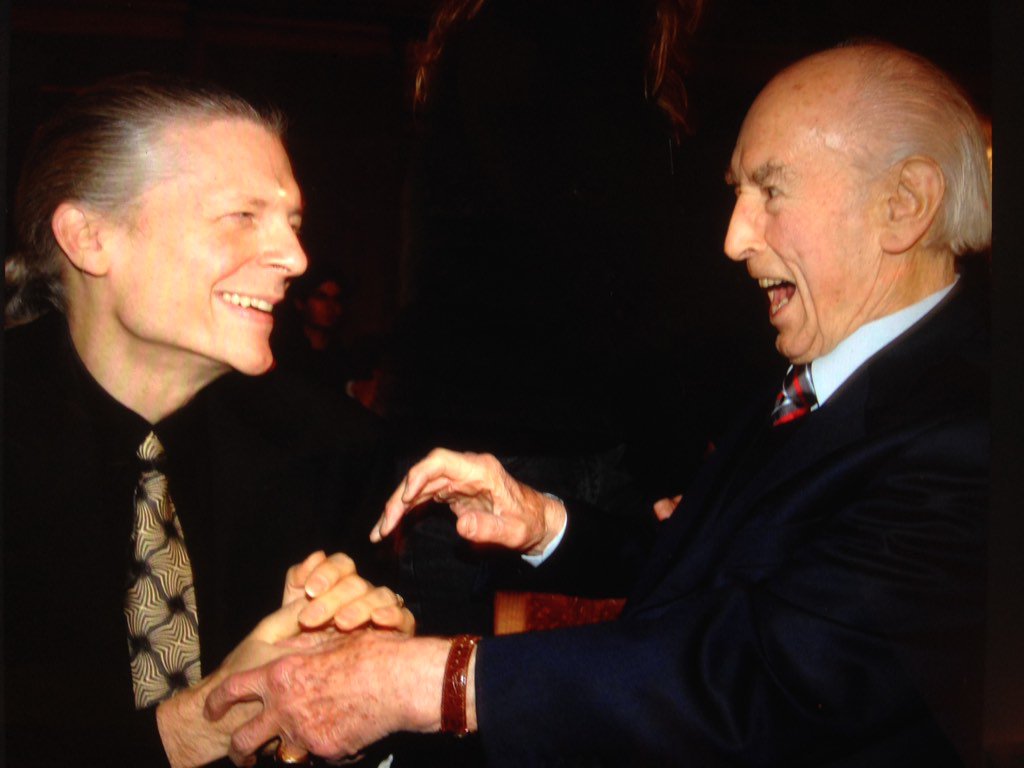
2b² - 2b + 1 = b² + 2b + 1
b² - 4b = 0
b(b-4) = 0
b = 4
a² + (a+1)² = (a+2)²
2a² + 2a + 1 = a² + 8a + 1
a² - 6a = 0
a(a-6) = 0
a = 6
(and this is how much I suck at math)
2a² + 2a + 1 = a² + 4a + 1
a² - 2a = 0
a(a - 2) = 0
a = 2
(but I know it is 3, so what am I going to do with it?)
(gosh, that is just embarassing)
2a² + 2a + 1 = a² + 4a + 4
a² - 2a - 3 = 0
(how important it seems to be to chose the correct x!)

D = 4 - 4×1×3 = 4 - 12 = - 8
wtf is wrong with me!
D = 4 - 4×1×(-3) = 4 + 12 = 16
x1 = (2 + 4) / 2 = 3
x2 = (2 - 4) / 2 = -1
It would be way better if they explained how they have figured out those formulas.
At least today we learnt how to use central number as the x makes the task easier.
then 21² + 22² + 23² + 24² = 25² + 26² +27²
a² + (a + 1)² = (a + 2)² + (a + 3)²
maybe me jumping over one step messed with my mind in the previous task,
let's do it slow and steady this time, since I do not know the answer this time.
a² + (a² + 2a + 1) = (a² + 4a + 4) + (a² + 6a + 9)
2a² + 2a + 1 = 2a² +10a + 13
2a + 1 - 10a + 13 = 0
-8a = -14
a = 7/4
thus no four integers can do that trick, but
1.75² + 2.75² = 3.75² + 4.75²
and it is obviously wrong. And definitely no such sequence is possible, since left side of the equation is always going to be smaller than right one. Unless a is negative.
2a + 1 - 10a - 13 = 0
-8a - 12 = 0
a = 12/(-8)
a = -6/4 = -1.5
(-1.5)² + (0.5)² = (0.5)² + (1.5)²
duh...
25 and 365 being that important is fascinating.

What if греческий ~ грузинский for they took their writing from sacartvelo. Why does it sound so italian? Why do they look sorta italian?
And I looked into the following table, and it didn't make much sense to me:
ა doesn't look anything like Α, but now (after I understood the next few lines) I see a the α in druli's.
For many years georgian looked like nothing to me. And just few minutes ago I saw Γ in vruli's გ, and I think I saw many of what I see now before: გ is г, but it's probably the first time I directly compare georgian and greek, and now I see that in such comparison გ reminds δ (d reminds c, as þ is both)
α β γ δ ε ζ η θ ι κ λ μ ν ξ ο π ρ σ/ς τ υ φ χ ψ ω
ა ბ გ დ ე ვ ზ თ ი კ ლ მ ნ ო პ ჟ რ ს ტ უ ფ ქ ღ ყ შ ჩ ც ძ წ ჭ ხ ჯ ჰ
and this comparison lets me tell that the myth of the priests of Apollo tells that those are the two strings added to the lyre by them. And georgian since seems to have added many more syllables.
And naturally I wonder if ξ is ჟ.
უ ფ ქ ღ ყ შ ჩ ც ძ წ ჭ ხ ჯ ჰ
u p⁽ʰ⁾ k⁽ʰ⁾ ɣ q ʃ tʃ⁽ʰ⁾ ts⁽ʰ⁾ dz ts' tʃʼ χ dʒ h
and it is interesting, that modern georgian alphabet ends at h, because I thought of ქ [k⁽ʰ⁾] to be the last similar letter between georgian and greek. No ψ, no ω, though in some variants there was ω:
Ⴥ ⴥ ჵ Ჵ U+10F5 hoe /oː/, Bats /ʕ, ɦ/ — Ō ō — — 10000
blue colour of its background tells it is obsolete:
This table lists the three scripts in parallel columns, including the letters that are now obsolete in all alphabets (shown with a blue background), obsolete in Georgian but still used in other alphabets (green background), or additional letters in languages other than Georgian (pink background). The "national" transliteration is the system used by the Georgian government, whereas "Laz" is the Latin Laz alphabet used in Turkey. The table also shows the traditional numeric values of the letters.[73]
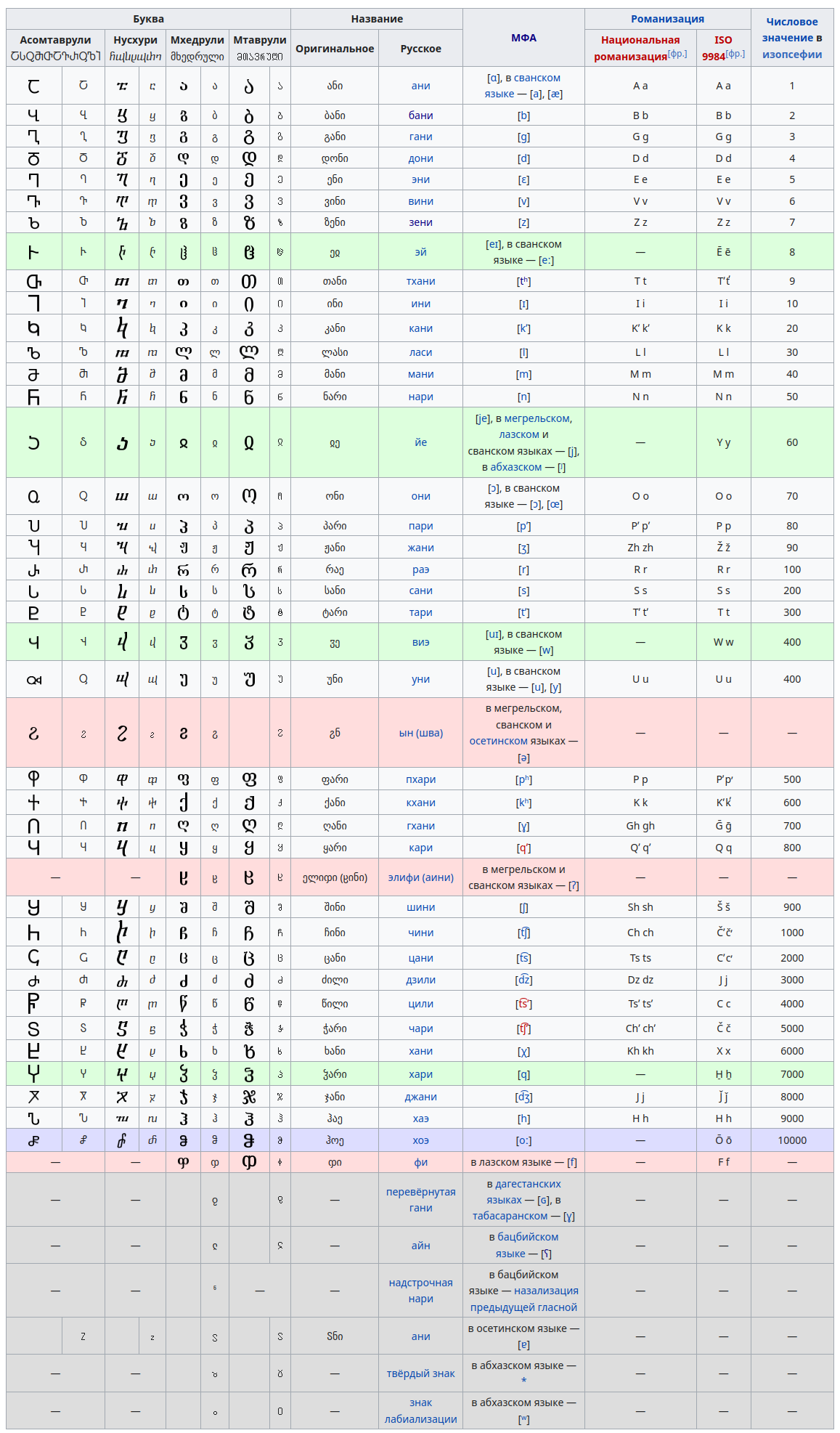
Once again, these shapes should represent the same objects as letters of other groups. And probably Ai can do it for me. The corpus of abecedaries are too large (but then even two of them are enough for comparison. So jews see bull in A, and I can see it the way
Isn't it wonderful, that ჶ after vowel ჵ is labial, even though it is facultative (not necessary, not present in all the georgian alphabets) and hat may tell that if I ever go there to find the origins of alphabets,
udder [а́да]
вода ~ в udder
udder ~ under [а́́̃да]
factual ~ actual (fact ~ facLA (do! (du~do? 𒊹 )))
for example ~ for a sample
udder
ãda
under
вымя
вы мя
вы меня?
вымой!
вымоя! (вымыв, вы моя (купил и обмыл))
prs is known all over the Europe: prays, praise, прошу, проси, пр-си ~ превозноси ~ pr-see ~ praise
o prs ~ o, prince! ~ o precious! ~ о перец ~ o pere S? ~ о т ц? ~ т = пр? for тятя ~ pere
NO!!! ThIS METHOD
IS TOO SPECULATIVE
poetry is for poems, but no, for research as well:
Sometime I follow the thought, but thus I hope it knows where it goes.
Subconsciousness is granted some great responsibility of finding what limited mind is not able to grasp.
poetry is for poems, but no, for research as well:
Sometime I follow the thought, but thus I hope it knows where it goes.
Subconsciousness is granted some great responsibility of finding what limited mind is not able to grasp.
o ба тя
o pe re
initial vowel is meaningless and pure междометие
But jewish abe makes aleph meaningless. abe and ima instead of babapapa and mama..
both are my, both are thus labial, but
then mother is more mwa
abe
батя
тятя
daddy
dad sounds as the name of the letter, as tet and mim. mom is the mim. mm. for me мама таня, и сейчас увидел что сходства m и т(т) в том что мама это мать.
а бабаTU это батяRU
при том что бабаRU это grandmother, short for bábushka (babúshka is old fashione shawl)
bab-a ~ babushka
pap-a ~ batushka?
bat-a ~ batushka
pap-a ~ ? p-a, pa?
mam-a ~ ? m-a, ma?
pa is for pater?
baba is batя father (f is б in russian, so efgh of english should be abcd for russians, fight ~ бой! feel ~ ?)
mama is mother
f ~ б (did fsб made me do it?)
feel ~ бил? felt ~ belt (ремнём бьют детей традиционно)
flow ~ блюю? flew
fly ~ бля!!Ё?
fall ~ боль (во тэто хорошее)
finger ~ pinky
forward ~ abordazh
foam ~ пена
force ~ бурса? бор-ца ~ бороться
source ~ сориться? (рассариваться ~ раздариваться, больше не дорог типа, отдавай мои игрушки) шериться?
fewEN peuFR
far bar? this word breaks that hypothesis once and for all
for бор? пор? pro! (far is пора́? долгий путь ~ рано выходить)
free ~ при ~ в смысле давай двигайся, you're free to go wherever you feel like it.
okay, the hypothesis is back on the menu
of is litearlly об
b~p, d~q? (да? ~ qё?)
babaTU~papaLA,RU
дядя~daddy? that turkic word broke the b/d antonymy. Because don't stick turkic into english!
papa = daddy (russian into english am I allowed to stick? how about latin?)
pater ~ father (so english combines da and fa itself. but not such words as dother or dather, зато есть русский в котором и батя и тятя и папа и отец)
отец батя папа тятя
отец папa батя тятя
father ~ daddy (is ther their?)
mother ~ mommy
fa of father is pa of papa
pater is the latin form
mo of mother is ma of mama
is no and never different writing of ונ?
Baba Deda
Femme?
Mama
Papa
If we ignore vowels, for sanskrit have them separated, why would it take vowels away? Why would it have different order if they're related? They probably took it from the source when vowels were separated: they only have three unique vowel shapes, all others are derivatives:
what other relative words could be in Mama and Papa lines?
МN: Няня, uNcle, auNt
PT: Papa Тётя
МN: Мама Няня
Baba Deda
Mama Nanny uNKLe and NKL win this race
Papa aunT?
Баба Деда (Grandmother Grandfather)
Мама Няня (Mommy Nanny)
Папа Тётя (Daddy Lady (not aunt, but some woman. and uNKLe is some daddy~дядя))
Баба Деда
Мама Ляля
Папа Тётя
Баба Деда
Мама Ляля Няня Кака тоже где-то здесь (и поэтому К в итальянском нет (не Khristos, Hristos))
Папа? why male noun for labial column? Russian is weird, silly, strange.. yet I am so unique about it and I found it in russian. And voiced-voiceless organization of russian alphabet is of russain alphabet (and russian doesn't have Q, so ОПРСТ reflect AБВГД better. П~Б, T~Д, that is fascinating, and both С and Г are like C)
Баба Деда-Дядя (баба тоже те только бабка, но и тётка (т моложе б? Б и Т как два типа женщин? легенды говорят что женщины это придумали, письменность вот эту))
Б и Т как Блядь и Тварь? Бабка и Тётка? Бывшая и Теперишняя? Былая и сТалая?
Папа Тятя ? В чём разница? как эти слова стали это означать? тятя от отетя от отец.
сЛАВа ~ ЛАВры ~ LOVE (ры как цвет?
буЛАВа is no LOVe (bu is no in the east, and boo is not to far from that. фу is another eastern no, and фуRU is booEN)
бить от звукоподражательного б, которое 𓃀, гулкий звук ноги. fist is probably of бой, боимст
бс: бойся
бтс: боится ~ боются ~ бойтесь (ся и сь возвратные постфиксы, без них боит ~ боют ~ бойте)
(боются ~
воют (но правильно боятся. без этой ошибки я бы не
увидел этого сходства))
бойтесь ~ войте
но почему войте не нуждается в сь? может сь указывает что б должна быть фрикативной?
молись вались белись пылись фаллись вафлись фэйлись винись
молись ~ винись, интересная парочка
моя ~ вина?
молится ~ мелится языком?
мо́лет мо́лит ~ ме́лет
молится значит умаляется, мелить значит измельчать. буквально мельчить (мельничить)
бойтесь ~ войте
но почему войте не нуждается в сь? может сь указывает что б должна быть фрикативной?
молись вались белись пылись фаллись вафлись фэйлись винись
молись ~ винись, интересная парочка
моя ~ вина?
молится ~ мелится языком?
мо́лет мо́лит ~ ме́лет
молится значит умаляется, мелить значит измельчать. буквально мельчить (мельничить)
well as the antonym of ill (i think I had this idea somewhere in the first notebooks, long negleted since)
(the idea of initial w being negation,
as if it was ũ the un)
her ~ ho ~ hole
him ~ hymn? ~ ham?
Here, three mothers are attributed to three celestial bodies, and in agreement with what I thought:
Manat for Moon (and both words are cognate)
al Lat for Sun (and probably it is a cognate to light)
al Uzza for Venus (and probably Uzza is cognate to V-s)
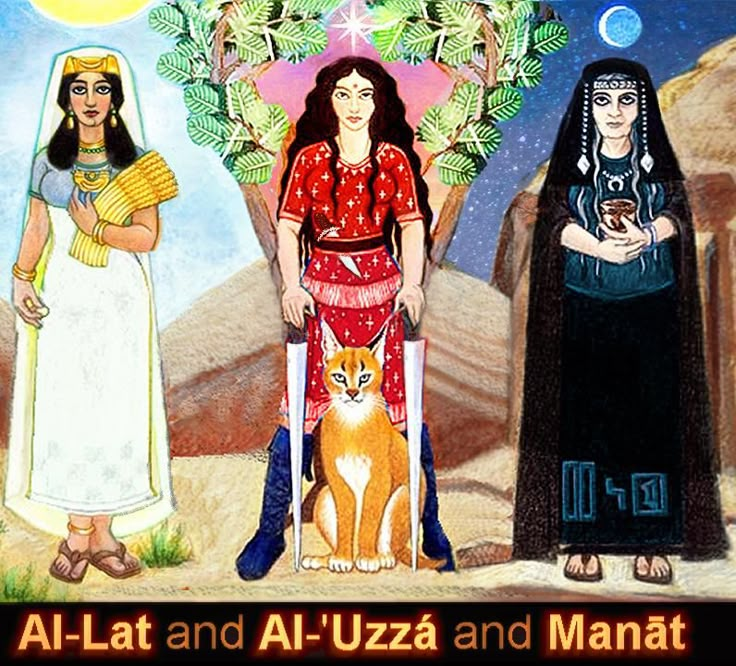
and if those are three stages of womanhood, then al Uzza is the evening star (predating the appearance of the Moon, I suppose, but then it's raw and speculative, I did not observe (I heard that Venus is both Morning Star and Evening Star, but people of the past didn't know that, but directly pre-islamic people could))
Al-'Mzzá (and that ', does it hide M omg!)
Al-'Uzzá (and that ', does it hide M?) mus as magic fly? Tinkerbell? Fairy is the word. Literally Фе́я.
(greeks read it Фея́)
(in greek it is literally goddess)
So she's goibng to transmit is transmitting (that typo of
a b made me think how hands typed it as to say that she
is. She is the only person actively helping me in all
accounts, and she handed my books to many people. (in greek it is literally goddess)
All legends tell of women, but it's really difficult for me to accept that women invented writing when ..and I wanted to say that guys at least say oh! when chicks only laugh: I have a distorted picture of reality: I have some friends who said wow, but most guys couldn't care less. And life have shown that those few friends understood very little of its importance and I just don't have many female friends. And my best friend who's my mom (by the fact she supports me and is the angel amongst humans) who doesn't understand it well, but she saw how my eyes burn when I speak of that.
Meditating on those names I saw that
a) they are U M L (al is their the) thus vowel, labial, lingual
b) that they are traditionally arranged as M U L and thus they are very much M N L
which correlates the IMNL of detski
alfavit
I should patent detski alfavit (or should I not do such a thing? I think they give one year since you threw it into the open access. So the question is closed. Fuck patents once again)
Arabic script, which is also Persian alphabet, which is also Kurdic alphabet.
Isn't it lovely that those three are A P K, as if they worshiped different of the three the most, and thus divided into nations as modern church separates into denominations each being a local authority.
Arabic script always fascinated me. By the way they may build ornamental patterns of their letters.
Thinking if from is of for (what is om? of?) I saw how in both cases fr are far
Is france far ass? жопа мира для кого-то? провинциальны как прованс
Today it's pretty much in the centre of it all, but what if fr in france is also far?\
Far end! It is for all to the East, because to the West of France is the Ocean, it is the far end.
(not just end of our land, but of all
land. far end)
land is lo end (lo is jewish no)
Lo! was an exclamation in one poem. It was jewish no, no?
France ~ far ends (at least as a poetic trick it is
incredibly awesom)land is lo end (lo is jewish no)
Lo! was an exclamation in one poem. It was jewish no, no?
(and chances are it is etymologic. So
name is of country, not country of name)
(so Руслан is literally Ярусский, that's why those who are less russian would bear it)
Is Dan of dam?
Is German der mann?
Is Svenska of svomi somehow?
These etymologies are speculative, but that is what most of this work is.
Speculative science. It is not in academic, but in philosophical tradition, and chances are it is better:
This type of science is not leaning to some experiments few of readers are able to verify. Instead it is basing the conclusions on the basis of well known facts and strives to construct a logical construction upon them. How logical are your speculations? Ai now can verify and falsify, factcheck and tell you where the text is shaky, so yeah, that's pretty much the future of science.
One of the directions it may take.
(so Руслан is literally Ярусский, that's why those who are less russian would bear it)
Is Dan of dam?
Is German der mann?
Is Svenska of svomi somehow?
These etymologies are speculative, but that is what most of this work is.
Speculative science. It is not in academic, but in philosophical tradition, and chances are it is better:
This type of science is not leaning to some experiments few of readers are able to verify. Instead it is basing the conclusions on the basis of well known facts and strives to construct a logical construction upon them. How logical are your speculations? Ai now can verify and falsify, factcheck and tell you where the text is shaky, so yeah, that's pretty much the future of science.
One of the directions it may take.
Just like true linguists seem to disenfranchise themselves from the ever corrupted mainstream by naming themselves otherwise (the field used terms etymology, grammar, philology, linguistics, now it seems they invented many other names for it, be it semantics or even pragmatics, I think semantics as a wider field, combining larger field than human tongues.
So now technology seem to be a more precise term for science, to disenfranchise itself from chomskies and lemaitres (literally jews and their golems, jews as less-of-a-people being put on top of the pyramid (it used to be used as a fire pit, was it not? Was it why the tops are so precisely placed by its size and is usuall in such a great condition to be from something of the top? Are they not filled with hieroglyphs? Could it be that all pyramids were? No, I saw the lower walls, and they were smooth)
I wanted to immortalize my relatives, but it takes not only my technology, but also their consent, so now I understood why
I found a different cure for cancer in this meta-analysis:https://www.youtube.com/watch?v=ahBab4YSPX8Could you please describe it from your perspective,so I could add it as a comment to that video.If you also sum-up the previous review also to be added to that collection of "thc cures all cancers by changing the immune system's pathways: it could indeed redirect it, because I don't smoke weed when I catch cold.
I also keep on working on my own rejuvenating project, it takes longer than I thought, and mostly because weed redirects me from it to more autistic activities, such as aeiou.nu and since that thing is mostly put on rails and its methods made obvious to a ai-assisted reader, I should give up weed again and force myself on actual reinforced concrete construction to build a womb-like bath for my, because we get dry and that is also why we die. We should drink and piss freely, as fish does.There is a majestic word-play supporting that hypothesis:
мы животные ~ мы же водные
(we're animals~we are aquatic)
A coincidence, but truly divine.
Technically it is a coincidence, but what if it is not? What if language flows around us by somewhat different pathways, and жить in животные~живущие is живчик(actively moving one) sharing жи with жидкость. But же is like yo (in both ebonic and japanese!) similar to enforcing verb do. Like I do want to be understood. Yet I got carried away by the hemp and that is why I take it: it helps me unravel the hidden pathways of languages. Yet, вода was the жидкость part. водный ~ же водный? же от жижа? Живой ~ двух жидкостей? ж и в are lingual and labial, good pair to explore. Ж is a combination of W and M, there is not reverse K to see it as double K
(though double
long single short thing allows it)
Ж as double M and double W contradicts the previous two systems: it is in direct contradiction to double labial single lingual thing, just as V and X, it goes to them.
And here is a huge question: is it all coincidence? Since doubling can be attributed only so many ways:
it can go from labial to lingual, yet VX WЖ go from
ШЖ is another group of doublings: single voiceless double voiced. And CG also can be seen as being in this group. So are СЗ. Are there examples of reverse doubling? That voiceless is half the voiced? I don't see them. B is always voiced, P is always voiceless. b is just a trancated B, or is it of some other yet related structure?
bd
pq think is very weirkd.
So it can also go
single short double long: БВ CS КЖ PФ[pf] 𐌐Ϝ
double labial single lingual: BD FГ ΜΛ ПТ Фq ФD ФР[fr] 𐌚𐌔 𐌚S
double voiced single voiceless: CG СЗ
opposing tendencies:
single long double short:
double lingual single labial: VX WЖ МЖ (nobody draws Ж like that, so these are weak paris pairs)
double voiceless single voiced:
So, the tendency is proven to be almost absolute, with one strong opposition in mathematical notation of VX, being numeral for any of the previous entities, be them V or X in quantity. And thus these two used to go final, and X ended the alphabet. And I wonder if ש is not W the V, double yet upside down ת
And would רש be rosh the head and thus a beginning, or did it start at feet? Literally 𓃀
Runes and ogham going from bottom to top. And that is going to be in n-teenth reason for archeity of runes (but then it is so speculative, it should be put in grey, if at all)
I wanted to see if tree of life supports it by placing letters from bottom up.
And it's not:
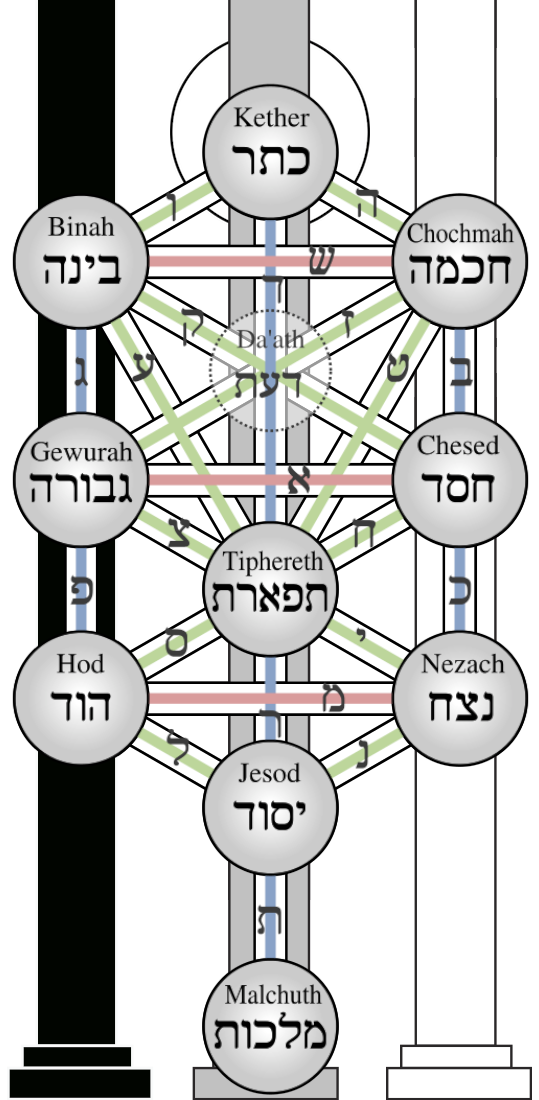
This variant places double letters at the vertical bars. And the position of ר is interesting: could it be misread ד and could it be how ר came to be, being misplaced in russian voiced-voiceless symmetry?
Could Kether be directly connected to Jesod? Beneath the Tiphereth?
This variant places three mothers at the horizontal bars, agreeing with the way ancients ranged elements by weigh. And it tells that there are only three elements, not four, not five. But then it only takes three out of five elements known to people of pre-modern time:
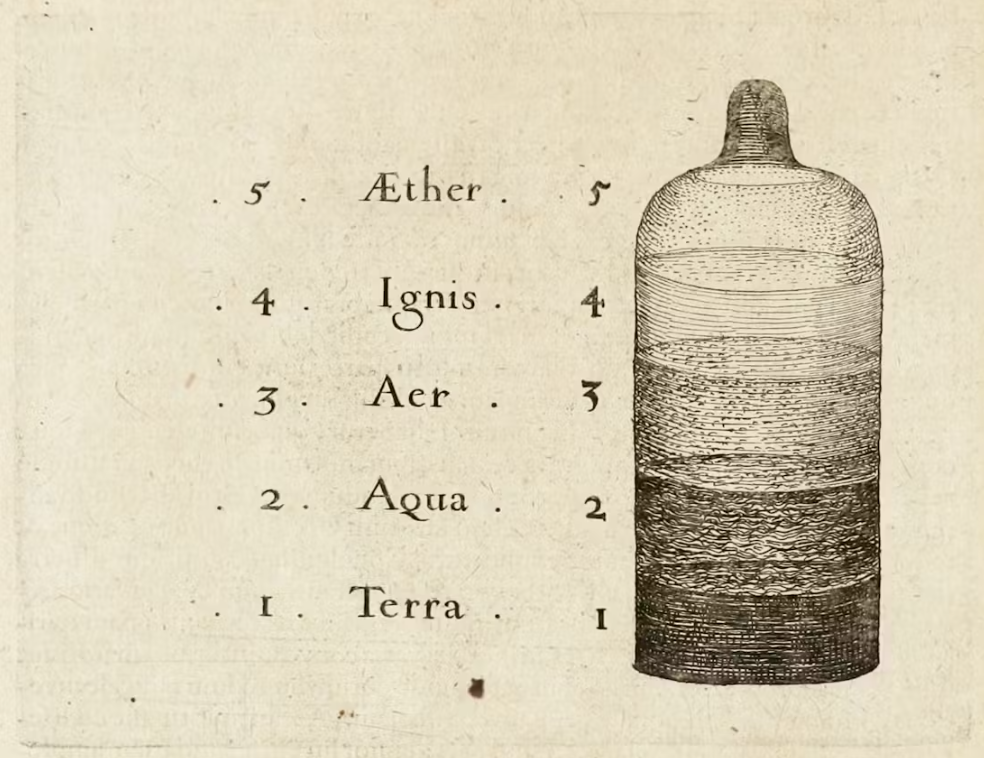
aether
(/ˈiːθər/, alternative spellings include æther,
aither, and ether), also known as the fifth element or
quintessence (quinta essentia)
Doesn't it make ת terra, and truthful set of elements
would be אמת, going exactly from bottom down, from the
lightest to the firmest, no fire, for it is what every
element can become, well, then they would transform into
one another. So because א was probably introduced later, B
and T were the beggining and the end, water and earth. not
M? B? Maybe they were listed and later summed up? as итого
sums up all of above, the common term, combining all of
the previous letter, that would explain מ and ת being at
the end of their halves, other wise some would think that
the alphabet would be taken in reverse, which is a big
no-no. And those are not exact halves, but then alphabet
was modified so much since then, no wonder. I wonder what
forms of liquid and soil would people know. Maybe the same
I can tell? Milk Water Blood Bile (wow, all have initial
labials) Venom Poison (also labials!) Mud!Water and Mere are labials too. But See is not. See is Ϻ, as ш looks like w, what is it? Different readings of 𓈖: one can say those with lips, other is for those with tongues. And if such groups of mutilated people ever existed, that should be a more widespread phenomenon, but maybe it crosses this theorizing away. But water milk blood bile poison venom mud tell well come on! One silly word, see is the shore! Some euphemism maybe.
And there is a different way to label those bars, but also from bottom up:
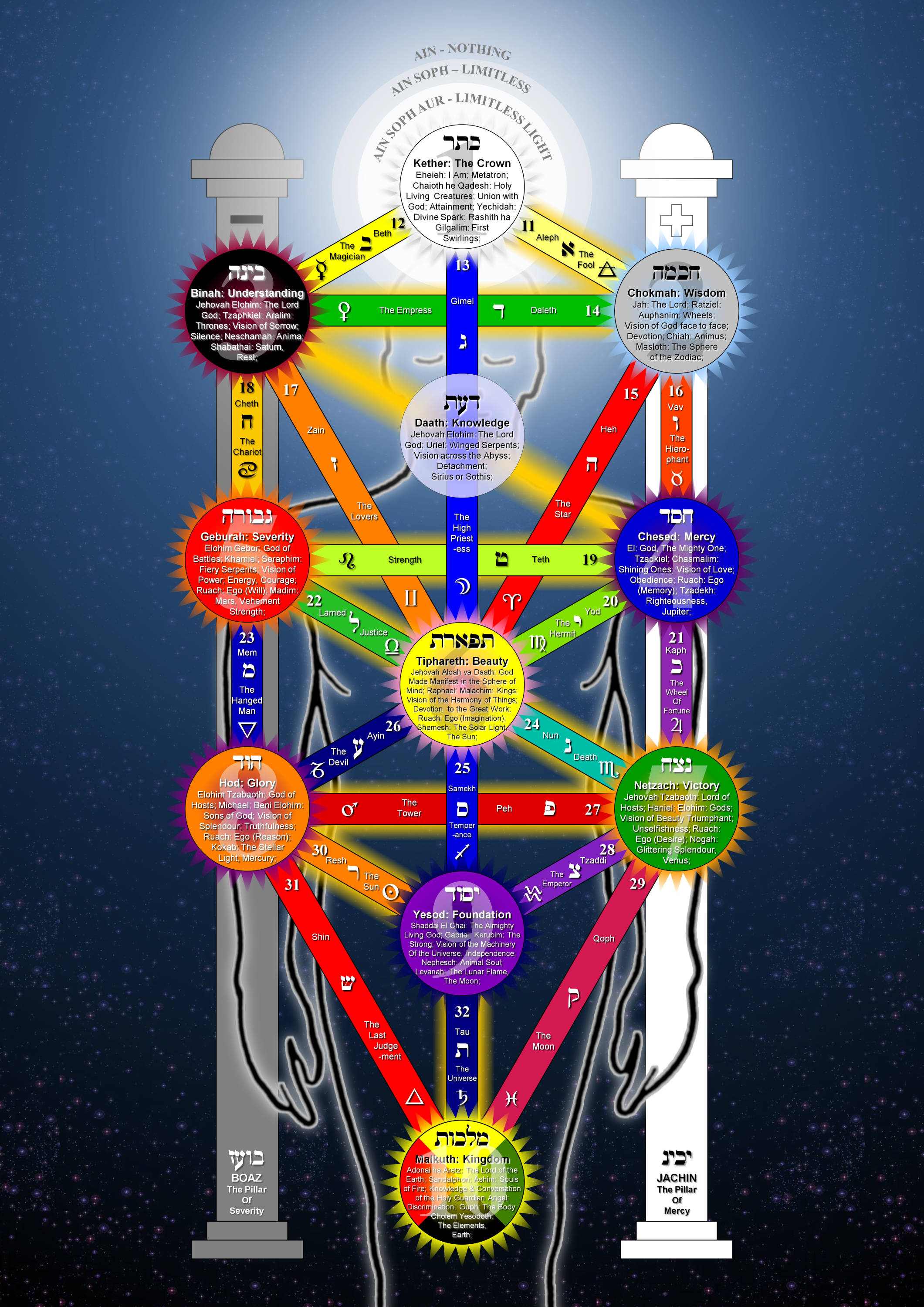
This version looks way more arbitrary, going from bottom up, but jumping around without any visible order. So I think I go with the previous one, the one having AMS as horizontal planes (as weighs distribute eachother) and vertical columns are of doubles, but didn't they mess up the Boaz and Jachin columns? Why wouldn't p be under b? why wouldnt k be under d? (and here it exposes the nature of dq pairing: d is also g? because q is quite k. When ᛆᛒᚦ were the first line, g and d were the same c so to say, and only two columns are revered by masons, and it's not פ and כ that's misplaced, it's ב and ג.
B for Bad, G for Good (according to the columns)
and there are many different trees of life. I've shown the plebean tree of life in the form of tetractis,
here's another one:
Logo of the Ministry of Culture and Tourism of Turkey represents the Tree of Life.
CG СЗ (is it why greek Ζ stands where G is in latin?)
Paris ~ pairs!
(yest it is a poem per se, and a great oe one)
dramatic ~ traumatic (but it was found in vol.40, which maybe proves it right. or way too similar)
Greatsy Great C? Great си? Great sea? Great Sea? Great pSy? S is for soul. p is for pnevmos probably, y is just a succ succ suffix of the Great. sy is the suffix, s is of t, just a subgarmonic of that accord of lips against eachother and voiceless. It is so wise! We cannot say not to do something absolutely, only to make less of it.
Грэйтсай (if it is psy, and that сай is eye, s is a призвук of t
GreatC Great D I am, why is it greatsy Great Die? Great D (Devil, Demon, Dracula, see, the letters have their charm. Deus is what they are having in common. Us is the suffix. So De is probably the D.
At least we found the new syllable: De is for Demon. D is for Dis, as in dismember. And is Death that very dis? D is for dis, D is for dis death
D is fourth letter of abcd, four is for Death in the east. how did it happen. shi is both four and death.
fore-futher are before(which were) fathers. fore, before, no more.
4 ~ д (one belly and two legs (and when belly is open, that's an option: 𐌱𐍂 are gothic B and R))
((does it tell, that they were written
from bottom up?))
((𐌱𐍂 are distincted by the state of the lower belly))
((The upper belly of B is not even necessary: B=Б=b(and is ь б? then ъ is d.. it's literally eR)))
𐌱𐍂 are the ЬЪ? The leftmost stroke of Ъ could go all the way down, or what was it I thought I saw:
Ꙓ, ꙓ (йоти́рованный ять) — буква старославянской кириллической письменности, которая встречается только в «Изборнике Святослава» 1073 года[1]. Данный символ построен как лигатура букв І и Ѣ. В глаголице отсутствует, числового значения не имеет. В состав букв кириллического алфавита не включается, потому и порядкового номера не имеет (обычно о существовании такой буквы вообще не упоминается). Собственное имя буквы неизвестно (и неизвестно, было ли оно вообще); описательное название «йотированный ять» — условное. Йотированный ять использовался в начале слов и после гласных: ꙓди, наꙓдъсѧ. Произносился, вероятно, как [jæ] или [je].
(third and fifth lines from the bottom (eighth and tenth))
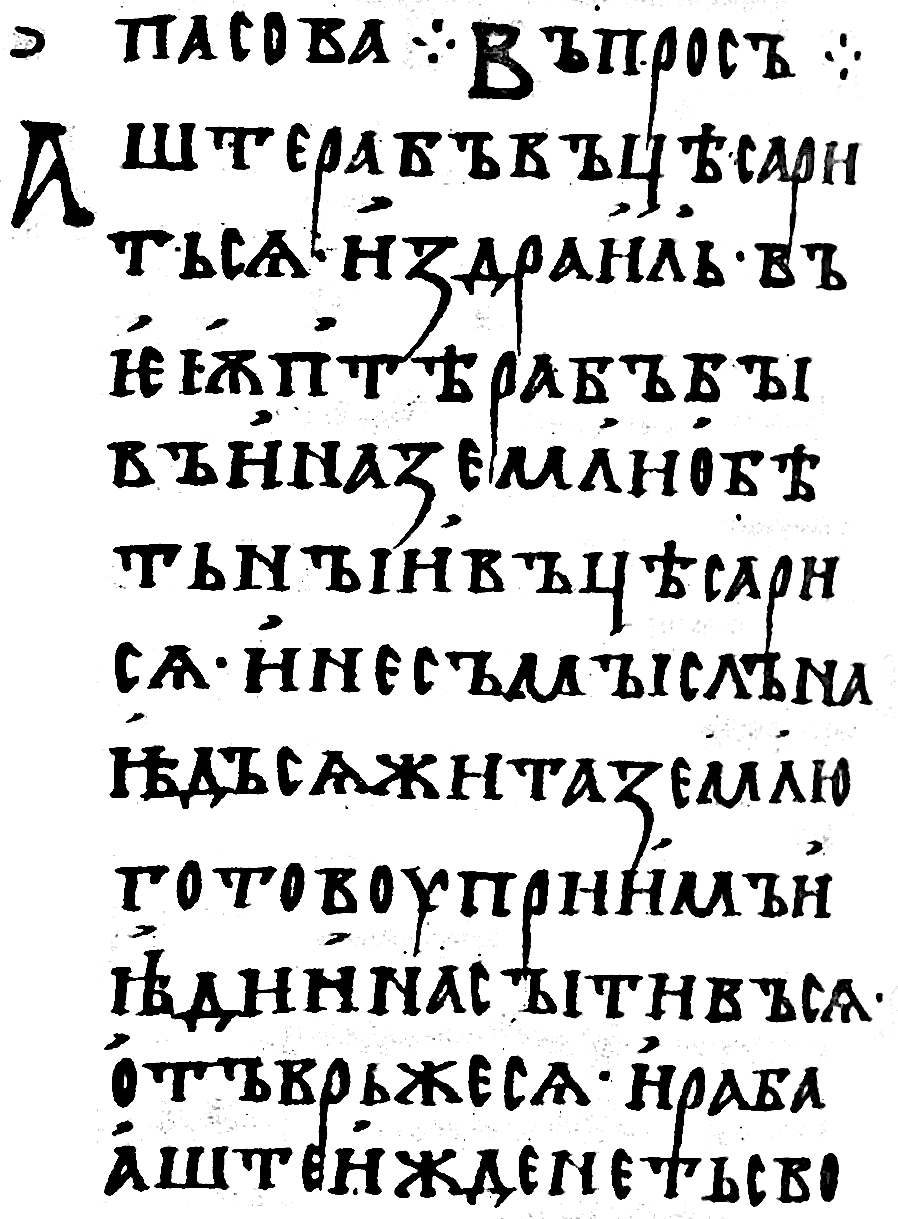
here, found it, ((𐌱𐍂 are distincted by the state of the lower belly))
((The upper belly of B is not even necessary: B=Б=b(and is ь б? then ъ is d.. it's literally eR)))
𐌱𐍂 are the ЬЪ? The leftmost stroke of Ъ could go all the way down, or what was it I thought I saw:
Ꙓ, ꙓ (йоти́рованный ять) — буква старославянской кириллической письменности, которая встречается только в «Изборнике Святослава» 1073 года[1]. Данный символ построен как лигатура букв І и Ѣ. В глаголице отсутствует, числового значения не имеет. В состав букв кириллического алфавита не включается, потому и порядкового номера не имеет (обычно о существовании такой буквы вообще не упоминается). Собственное имя буквы неизвестно (и неизвестно, было ли оно вообще); описательное название «йотированный ять» — условное. Йотированный ять использовался в начале слов и после гласных: ꙓди, наꙓдъсѧ. Произносился, вероятно, как [jæ] или [je].
(third and fifth lines from the bottom (eighth and tenth))

especially the third :glyph
 (mirror)
(mirror)AMT instead of AMS should be in the beginning of the book. Those are letters jews make golems, so the legend tells. So should I open that second volume with that off-put AMS? or on-put AMT?
AMT is a legend (and AMZ is a non-formal name of the psyclinic in tjeljabinsk)
Suddenly I understood that I am able to
improve tjeljabinsk's status:
as artists improve districts, so we can improve whole country.
First remove the cryptocommie retards.
The friendly merge with the US? They're literally НАШИ, няши
на=on=ã
that ̃ confuzes me:
ᛋ has three strokes.
so is S for sri?
edimus bibimus srimus? (mus is типа мы, только на латыни, ы это мн. число, как и s)
(but us is single masculine, not plural.. but maybe htaths not latin)
ешь пей спи (или сри, тут уж как кому, наверное правильно спи, а сранья надо с ранья)
PР читаемая как R это гусары всё засрали?
опошлили, оглупили, солдатня
русня и срёт ещё в чужих домах
ненависть порождает ненависть
может это мои репорты такое натворили?
я писал, что европейские страны друг друга недлюбливают,
может не напиши я это они бы и думать об этом не думали, не лезли бы из кожи вон рассориться со всеми вокруг и вообще?
слишком много на себя беру,
но вероятность этого не нулева, не надо писать хуйни.
(хуйти было стёртой опечаткой, типа подсохознания говорит хуй тебе, мол будем писать любоую хуйню. это реалистичный прогнос и напоминание что нужно плохие стихи записывать, чтоб они хорошие не задерживали)
(может поэтому здесь половина "стихов" хуета? но вторая половина просто охуенные:
(Paris ~ pairs!)
(Paris pairs)
as artists improve districts, so we can improve whole country.
First remove the cryptocommie retards.
The friendly merge with the US? They're literally НАШИ, няши
на=on=ã
that ̃ confuzes me:
ᛋ has three strokes.
so is S for sri?
edimus bibimus srimus? (mus is типа мы, только на латыни, ы это мн. число, как и s)
(but us is single masculine, not plural.. but maybe htaths not latin)
ешь пей спи (или сри, тут уж как кому, наверное правильно спи, а сранья надо с ранья)
PР читаемая как R это гусары всё засрали?
опошлили, оглупили, солдатня
русня и срёт ещё в чужих домах
ненависть порождает ненависть
может это мои репорты такое натворили?
я писал, что европейские страны друг друга недлюбливают,
может не напиши я это они бы и думать об этом не думали, не лезли бы из кожи вон рассориться со всеми вокруг и вообще?
слишком много на себя беру,
но вероятность этого не нулева, не надо писать хуйни.
(хуйти было стёртой опечаткой, типа подсохознания говорит хуй тебе, мол будем писать любоую хуйню. это реалистичный прогнос и напоминание что нужно плохие стихи записывать, чтоб они хорошие не задерживали)
(может поэтому здесь половина "стихов" хуета? но вторая половина просто охуенные:
(Paris ~ pairs!)
(Paris pairs)
à Be GooD
Eͭ iF Go Hi(GH)
I May Nay Lay
O PeRe Say ToV)
is weird, but O PeRe So ToV is promising
What! Pere is french, Say is english, ToV is hebrew!
Be GooD is pure poetry.
FiGHt?
IMNL to fight immanuel?
OPRST oh parasite? was q the axe to cut the head of parasite? p is mouth, r is head. between mouth and where the head is cut off, right to the q the brain.
was O in PRST? or was the line prstu? parasitu? situ is place. para is по ту сторону. parasite is that site? the neighbour is parasite?
I removed A from Be GooD and it became better. FiGHt is not perfect, but E is Et, as A is And.
Now when O is challenged in PRST line, that makes me question validity of I in IMNL. MNL is манул? малин манил? заманивал, магнит манит. Это русское слово? Русские горы его породили. Магнитогорск недалеко от Челябинска. Города должны стать независимыми.
expensive ~ expansive (insane expansive atrocities (those are wars, as a complex kenning. Expansive atrocities would be enough, atrocity have insane in it already. Expensive was the word, but that typo brought to my attention that similarity in both form and meaning. They're naturally cognates.)
bright people are более right (b is big, bigger=больше, better)
left beouble are
people
p u blic e ~ ic? e ~ c?
a~Б
с~e
f~г?
г~h?
f~h?
h~и~i
i~j
j~k? or j~l? or I~me!
aбсегhimõpрt B~C? shapes are similar meet as в and г when чего is read as чево. Maybe it makes vav exist between e and г.. is it a silly poem? it's an attempt to write a very good one.
Αμυνα is defense in greek. And it could be cognate to latin amica (дружественные) friend
(because defense is the antonym of
attack)
(friend protects you too)
(friend protects you too)
Thank you. All my wish come true and I'm thankful, grateful (full of thanks, full of "great!"s)
Who do you write it for? For whoever it may cencern (I leave typos so more random people can find it)
(my own
образованность мешала мне понять это. может и тем кому
отправляю мешает)
her (её) хер её? herr господин~госпожин? vrow of vir? vir is husband in latin [хё]
vrow is of vir, vir is v'er (viewer? fucker, ficker, въher (wichser? nah, that one is wanker))
vrow is of vir, vir is v's (er works that way: baker is bake's, and so is for every profession)
thus her is he's or even H's.. but his is literally his. Did they distinguish between he and she?
What is if it's not h modifying s, but s modifies h? sh язычная h, ph губная h (h of pey?)
he and she are different in that ass, his and her are different in the ending, and they seem to be different forms of the same. Of plural suffix: es is of english and french, ar is of german and turkic peoples.
haar
его как родительный падеж и как множественное число? не в его, но в других словах:
карата (как 2 карата) и родительный падеж карата (не хватает одного карата)
но а это не множественное, это так называемое двойственное число.. может подставляли букву по ранжиру чтоб делать три числа, три рода, три времени? три гласных было?
караты карату карата (карато и карате уже не грамматические формы of карат)
караты именительный падеж (мн. число)
карата родительный падеж (ед. число и дв.число)
карату дательный падеж (
и р д менее круто чем и п д: р была пр, прородительный. продительный? породительный. пр как пердёж запросто сопоставлялась с рождением, потому что говно тоже по сути рожают. с родами и сраньём? срать это s как shit использует?
роди где ди суффикс "дей!" (и мы нашли ди к тей де, и мы нашли ро к ним обоим)
время для нового файла: силлабария
cut is резать (и knife скорей всего ту же k имеет. без неё nife гораздо ближе к нож, и
Ж первая согласная во второй строке русского алфавита.
F первая согласная во второй строке латинского алфавита.
жена ~ femme но не буду спешить Ж и Ф роднить.. if F is double Г, then it's Ж! может пора? FГ
(сказал я собираясь завести новый файл,
но..)
isn't Ж G которая Г?
fuck ~ жать (а вчера одну зажал, под себя её подмял, и как плугом борозду пропахал её пизду)
fuck ~ жаритьisn't Ж G которая Г?
fuck ~ жать (а вчера одну зажал, под себя её подмял, и как плугом борозду пропахал её пизду)
from жром
for жор.. ж ближе к д чем f, r~l, so для становится ближе, но жром это не оправдывает.
может from появилось после разделения
народа?
vir is of v (femme)
муж is of м (мама (ма как любая баба? баба~мама? grand mother же))
жена ~ мужена
муж ~ мы ж? принадлижащий ме. мы как we принадлежим Ма? we belong wa?
beat is of bite: our food is quantized by chews, literally split.
beat is bit
I Ching is drawn from bottom up:
The lines of hexagrams in the context of the I Ching (the ancient Chinese divination text) are called "yao" (爻). A hexagram is made up of six yao lines, which can be either solid (yang) or broken (yin). These lines are often referred to numerically based on their position in the hexagram, from bottom to top:
First line (bottom line, position 1)
Second line (position 2)
Third line (position 3)
Fourth line (position 4)
Fifth line (position 5)
Sixth line (top line, position 6)
and here what I found:
Be and Do are Be and Go, Do and Go are both g. as the opposite to б
g and б look exactly like 9 and 6, and they support the lingual-male labial-female theory
9 as both go and do
6 as be (stay (be~here))
Are not lines of hexagrams having those exact numeric values?
be good is 6 99
be bad is 6 69
be dead is also 6 99
is it why there's a formula good (russian, or indian, whatever) is dead (russian, indian, whatever)
Grok tells about it better than some humans:
6: Changing yin (yin → yang)
7: Stable yang
8: Stable yin
9: Changing yang (yang → yin)
The reason they need to have changing lines is that they predict the future. Stable lines don't change in the hexagram of the future, while changing lines are itself in the hexagram of the present and reverses in the hexagram of the futrue.
The human text I read only knew 6 and 9 as their names. Maybe they're different traditions? But grok tells no. It tells that maybe some modern practitioner uses his own simplified version of it, sure, but no tradition of such is in Grok's records. So I was disinformed by some sloppy human. Gosh I wish Grok doesn't suddenly conspires to full me.. This part is an ai-assisted science, take it with caution.
so could it be that go and do were those 7 and 9 ?
and then go is definitely 7. now let's check the chinese meanings and see if they align..
6: Changing yin (yin → yang)
7: Stable yang
8: Stable yin
9: Changing yang (yang → yin)
go is stable go, do could be here, could be there: now you go (take the instrument) but then you come and do.
Б and В!
[b] [v]
6879 is the order of бвгд (literally бвгg)
but what is в[v]? v is въ is in in russian. as if it's in there, but soon not anymore? like wood in furnace? like shit decomposed in the soil? There should be something else, something
future is like fu-true (not true (in the future maybe, but now not true. русский поддерживает: бу-дующее (не действительное (прошлое на нас оказывает влияние, а будущее нет, но видимо дущее оно же деющее.. но я даже старого русского не ведаю, спекулятивное гипотеоретезирование))))
E was felt by Grok (on the basis of some scientific book of phonetic associations, as it said) as lightness, brightness, glee
Non of those three words it used have initial e.
e shows a smiling face. Maybe mayan is not as far as we think.
To link mayan to chinese or european, that is my task now. Well, a subtask. Main task is to work with russian and english to unravel the pre-literary forms of it.
бвгg as 6879 and it is all rooted in I Ching?
Geographically russians are closer to chinx but it's rather savage.
в could be vidi, as if di there is the hidden meaning of the future hexagram, while be is vie.
(for it is something which sugests turning passive observing to following actions)
Naturally, I understand how insane it seems to link russian alphabet to I Ching, but facts are facts.
Whether it's an incredible coincidence, a chain, a mail of coincidences, or the history of the writing systems are totally made up. And yes, I know now that it is mostly made up, none of them know anything of the inner structures of it. So am I saying бвгд are 6879 of I Ching? duh, complicated.
It shall take some time to digest
something like that.
> Milk Water Blood Bile (wow, all have initial labials) Venom Poison (also labials!) Mud!
Wine, Beer, Vodka, Wiskey, it's incredible how they all start with labials.
Juice/сок and cogniac are rare exceptions of that line. Drink is also a weird word in the context.
пить~петь
drink~sing
probably a coincidence
моча, but сака, but that one of ссать, and who knows if
it's shortened of писать or if писать is bilingualdrink~sing
probably a coincidence
and who knows if urine is actually not marine. because it's salty as маринад (рассол is not of labial)
кефир, кумыс,
квас,
what is going on here, why so many of them are of k?
jin and tonic, so are those labials my cherry-picking or is there this tendency actually present?
what is going on here, why so many of them are of k?
jin and tonic, so are those labials my cherry-picking or is there this tendency actually present?
Be (be & bi)
Bo (bo & ba or bo and bu?)
Were there two mothers at first? Two dots on our life? Was present conceptualized by some philosopher as a present?
pP & F
past & present & future
NOT to understand now as not present is way simpler: you don't have to understand what you feel.
Why would I focus on the past either? To see how I can go to the future I want.
But then maybe an hour later I realized that we register the present to memorize it maybe.
If we only focused on the future we would be unbearable, rude as wild animals.
some beast wonders it's you calling me
rude?
ring rang rung
I A U (classical descending triad)
E O
or
I A U
E O
? reng же, так что если что не в этом контексте. если вообще. будем наблюдать
some e's are of
i, some e's are of a? будем наблюдать
think thank thunk
sing sang sung song
sink sank sunk
swim swam swum
lag~log? (задержка на дороге вызвана упавшим на дорогу бревном?)
was log kept by mentioning all the logs laying on roads, so that officers check if some of those logs were bandit traps, who didn't dare to attack the army, but were waiting for merchants with smaller guard.
ring rang rung
begin began begun (by gong?)
drink drank drunk
These two are in their own category:
do did done
go went gone
instead of i a u [i e a] they go u-ow i-e a-o (u i a? о e a?)
gun гонит (снаряд вперёд)
and another category:
drive drove driven [a o i]
a o i-e? what? that's so arbitrary! they forgot the i e a formula, they went deep too: do [dv ~ davai]
write wrote written [a o i]
ride rode ridden (road is rode!) [a o i]
rise rose risen [a o i]
and the most weird category of them all with only one verb in it
fly flew flown (so chaotic!) [a u o]
fry frew frown?
Google translates דו as two, and two as דו (I wonder if it's their trick or is it g.t.'s bugging, but I wasn't taught that, I was taught only these two (they're different by gender, total fuck up, I'm not even sure which is which)
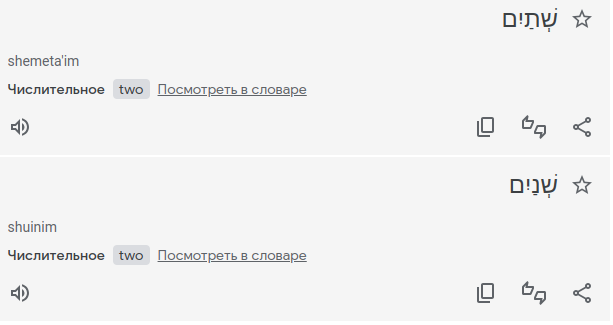
two girls are שתי בנות, thus shtaim (and behold how that shit transliterates it!
they're shtáim and shnáim, at least that they taught us well. They might think "du you would recognize, it's yiddish I guess. But no, two girls are צװײ מײדלעך, deutsch zwei)
two boys are שני בנים, but then they trick us again: ben is son, not boy, and bena thus is daughter.
From the context of "do you have children?" "two girls" it was taken from.
Naturally, it seems to be the most frequent use of the phrase.
And I think they taught us wrong in the way that
I would tell that shtaim is for boys and shnaim is for girls.
I think I would link t in shtaim to suffix ot
and I would link n in shnaim to suffix im
And it always confused me: im is a male plural suffix, why would it be used in a word for females?
And it seems it is not: shtái, not shtáim
מען and מע are interesting. Where did they take it from? See, it's an european language, it may preserve some european words. Well, who knows, who knows..
Words like
arm [а́ам]
fork [фо́ок]
make R remind japanese 々
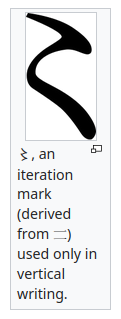
And it happense to be not just japanese, it is the iteration mark used in kanji and chinese as well.
Kana uses different iteration marks; one for hiragana, ゝ, and one for katakana, ヽ. The hiragana iteration mark is seen in some personal names like さゝき Sasaki or おゝの Ōno, and it forms part of the formal name of the car company Isuzu (いすゞ).
Unlike the kanji iteration marks, which do not reflect sound changes, kana iteration marks closely reflect sound, and the kana iteration marks can be combined with the dakuten voicing mark to indicate that the repeated syllable should be voiced, for example みすゞ Misuzu. If the first syllable is already voiced, for example じじ jiji, the voiced repetition mark still needs to be used: じゞ rather than じゝ, which would be read as jishi.
While widespread in old Japanese texts, the kana iteration marks are generally not used in modern Japanese outside proper names, though they may appear in informal handwritten texts.
пакли как палки (моя причёска: волосы в разные стороны как рога торчат)
пак как пачка, пачка волос. Даже при том, что правильным словом будет пучок
па́чки пучки́ (первое женского рода, второе мужского рода)
па́лки полки́ (ритм определяет гендер слова? мужской закрытый? на слабой доле. прикинь как бы я возбудился будь оно наоборот)
но па́нки мужского рода же! ди́мки даже не так удивительно, учитывая что димка заканчивается на а, но панк-то какого хуя?*
Не похоже, что есть существительные женского рода, которые склоняются в множественное число по мужскому шаблону.
тоски́ это родительный падеж, что может объяснять, что мужи́ это мужья музы (матери)
а муж муз (матере́й)
Не слишком ли смело поставил я зкан равенства меж музой и матерью?
Кто муза в реальной жизни? Женщина, которую хочешь восхитить.
Кто первая женщина, которую хочешь восхитить? Матушка, мамочка, мама.
Не слишком ли смело поставил я зкан равенства меж музой и матерью?
Кто муза в реальной жизни? Женщина, которую хочешь восхитить.
Кто первая женщина, которую хочешь восхитить? Матушка, мамочка, мама.
dogs' songs are good to steal some cool rhythm from them. The semantic side of the transmitions is hardly ever decyphered.
Three steady "bow"s with a period of one second between each two bows seem to end the conversation.
(it is yet to be tested properly)
подъезжает из другой комнаты услышал как а́еа́е (и понял по контексту)
контекстуальное прочтение сообщений (всегда таково, но до какой степени вопрос)
письмо некоторых африканских и индейских народностей считается протописьмом из-за контекстуальности или символизма что бы он не значил в сиём контексте. Протописьменности следует изучать, потому что едва ли наша протописьменность канула в лету насовсем.
Где-то оно лежит, спрятанное in the
plain sight.
Isn't it crazy that 4 is for Death in the East and in the west D is the 4th letter, and isn't it chinese influence that three of abc, the ᛆᛒᚦ were substituted by four elements instead of 3?
Amongst four riders of Apocalypse, Death is the fourth. Are the previous letters the other three?
A B C D
В is война? yes, war is the second rider.
A is чума, но почему а?
C for famine? Г is for голод
Многоязычие нехорошо. Война Голод Дeath (про чуму раньше не знали видимо, просто болеют, просто умирают, но может и знали, но нет, это знание тоже пришло со временем. На каком этапе человечества или до его? Откуда бы я знал?
А В Г Д
Food
Жрут
Gr ~ double Г ~ F?
Жарить
to fry
ь is you, you, you! побудительная частица. ит = to = то
Гореть
to burn (and here we meet our Б~Г correlations, and Ж/Г = Ф/Б)
ж and f (both follow eё) definitely substitute each other too often
А В Г Д Эпидемия Война Голод ДубаДал
Could alphabet open with these four?
Аз Батя Дед
E Female et Femme? Et Feya? Et Zheŋa?
I Mommy Nunny (nanny ~ nunny? women who don't have children and thus don't have much to do?)
O PaTeR
U VeX?
Батя Дед
Father Grandfather these two are very interesting, but what can I put into other lines?
Mama Няня? maybe some other language uses I-lines words for those two words?
Pater (and grandfather is avus in latin)
I sorta realize that those three words pretty much negate the female lingual labial male theory.
Mama is Father in georgian.
მამა [mama] father
ბაბუა [babua] grandfather
მამა ფროსტი [мама прости] дед мороз
Болезнь Война Голод Смерть (plosive-fricative, plosive-fricative (labials, linguals))
6 8 7 9 (9 looks like S too, btw. And what is better for the role than the last digit)
1 2 3 4 (or)
Б Г (6 7)
V S (8 9) 𐌚 S (or, maybe 𐌚 g [f d])
крАсн(-а, -о, ъ(and it exposes е between с and н), ый, ые, ое, ую, ым, ой, ого, ых, ыми, )
ых и ыми are obviously их и ими
A Б В Г СД ~ death
болезнь война голод смерть
холод же! (б~в, г~х (может звонкое? ɦолод?))
((обглодали?
кости торчат?))
Four horsemen of apocalypse expose BVGD or BVGS? No, voiced line it is. In russian, greek and hebrew and georgian and arabic and latin's anomaly is registered to be made so by some Ruca or Ruga. Could it be Luca?
Is that less precise because all three are forms of death?
disease violence hunger
illness violence hunger? death? for D is 4
illness war famine?
plague war famine mort? four forms of labials? v is for violence, b is for beating
мор
I used to think: "where is China and its I Ching and where is Europe and their four horsemen!"
Now I'm sure wisedom travelled as well as other goods and no separation in human culture is actually present or ever war a was at large.
(𐰅(𐰅TURK ~ (𐲋 ,𐲉)𐲊HUNG
both runes are [e] and both writing systems go right to left
(probably, khazarian has to do
something with it)
𐰀(𐰂𐰁)TURK ~ ᛇNORSboth runes are vowel (a for turks and i for norsemen)
(but then ᛇ seems to also have
consonant reading ([iː], [x], [ç]))
𐰆(𐰆)TURK ~ 𐲛HUNboth runes are o, and turk version is also u, and turk (the old-turk, gok-turk version) is definitely of 𐎓ʿ(ɔ)
There's definitely plenty to compare in those scripts, but I leave it for now. It seems I don't like pushing all different writing systems into my mind. It seems to be enough of input for the output to produce. I put it into there by portions, so that 𐰆 ~ 𐎓 thing I didn't know just some minutes ago.
I knew 𐎓, and now I linked turkic 𐰆
to that, and hungarian 𐲛 is definitely them and ɔ
(I wonder why they are not reversed, since the direction of writing is)
so 50 or so insights into them and I get to know them.
I still don't know some runes, I didn't know that ᛇ has consonant readings ([iː], [x], [ç]) minutes ago.
So, so we learn. Here I show you how.(I wonder why they are not reversed, since the direction of writing is)
so 50 or so insights into them and I get to know them.
I still don't know some runes, I didn't know that ᛇ has consonant readings ([iː], [x], [ç]) minutes ago.
I was always upset that scientists only publish their conclusions and not their way of thought.
Now I deliver you that. To kickstart
the tradition, to show you the way.
𐎀a 𐎁b 𐎂c 𐎃ḫ 𐎄d 𐎅h(e) 𐎆w 𐎇z 𐎈ḥ 𐎉θ 𐎊и 𐎋k 𐎌 š 𐎍l 𐎎m 𐎏 ḏ 𐎐(𐎃 rotated 90°)n 𐎑 ẓ 𐎒s 𐎓ʿ(ɔ) 𐎔п 𐎕ṣ 𐎖q 𐎗r 𐎘ṯ 𐎙ġ 𐎚t 𐎛ỉ 𐎜 ủ 𐎝s̀ 𐎟 ugaritic
𐎠a 𐎡i 𐎢 u 𐎣k 𐎤ku 𐎥g 𐎦gu 𐎧x 𐎨c 𐎩j 𐎪ji 𐎫ta/ti 𐎬tu 𐎭da 𐎮di 𐎯du 𐎰θ 𐎱p 𐎲b 𐎳f 𐎴n 𐎵nu 𐎶ma 𐎷mi 𐎸mu 𐎹y 𐎺v 𐎻vi 𐎼r 𐎽ru 𐎾l 𐎿s 𐏀z 𐏁š 𐏂ç 𐏃h old persian
Why would old persian 𐎢[u] add 𐎭[d] to ugaritic 𐎓[o]?
Cuneiform was in use c. 2900 BC – 100 AD Did christians eradicated cuneiform?
Old-turkic runes were in use 8th to 10th centuries
Some seven century gap is between those scripts.
Some transitionary tradition which pulled 𐎓 through to 𐰆 should exist. Or some redefining those time periods can do the trick as well.
Ugaritic is told to go extinct in 12th century BC.
Old-Persian is told to exist in 525 BC – 330 BC

They say it has no letters from other cuneiform. So was it a later stylization?
How much of the previous letters they actually knew? After all of all vowels only 𐎢 has that 𐎓 part.
And of all -u syllables only tu doesn't have the 𐎓 part. In syllables with other vowels 𐎓 is less insistent.
𐎼[r] and 𐎾[l] have the central horizontal stroke to the right or to the left respectively.
Check them in the table above, there it is clearer.
And s- is also similar to them. Is it for centre? and va is
similar to that sa/si/su
The way 𐎶[ma] reminds 𐎫[ta/ti] reminds me of m being
similar to russian т the т, and 𐎬[tu] reminds
russian Т too.ichi and hito can be seen as having initial vowels (H is И in greek today) and chinese yi too.
futa and ni can be seen as having initials labials (N is not far from M: мы, но нас (us~nus~mus?))
san is obviously having initial lingual, but what about Mi? could it be the M~Ϻ thing? could japanese mi and english three be cognates? I seriously doubt it, but to M~Ϻ it goes.
Could it be that E and B are the same letter? the same Be
Е looks like tilted m so is B tilted m?
m Ვ w ? but w is closer to m than even Ვ! doesn't iot tell that they're in a ring relations?
Ვ is georgian f the [v] the staveless B I was looking for.
why does that Ვ the В[v] look like З? fricativity matters more than lingua-labiality?
is liability of
labial? hardly so.
цика́во ~ це кого́? кого[kavó] прочтение г как v говорит
что даже плозивность-фрикативность не является
определяющей характеристикой. и звнокой звонкость-глухость
не являются ей також.Либо являются, но не во всех
контекстах: кот и код отличаются именно что по
звонкости.
Here I wanted to find words different by plosive-fricative, (but first I found the counter-example: but varvára is bárbara, and then I saw that no such pairs exist: big~wig (head is bigger, and wigs big shots wore. such as jewish wome? yes, and they as well and are, maybe hence the tradition, from faraos. Do you take their fairystales on fatih? They seem to believe it, so such is their model of the past. What it actually was how would anybody know) and thus l and r may be the plosive-fricative pair.
Are n-m too? or was it ΛΜ on that short half of the long)
cat ~ hat?
кот ход, кот сит.
none is exactly synonyms, but all can be immediately linked (шкуры на шапку, гуляет сам по себе, сидит как сфинкс, реже лежит (на спине например, или на брюхе))
boot and no such word as voot. yet wood. and foot! is boot=foot?
so they can be voiceless, fricative, but as long as it's also labial it is the same word?
b and f just flow into one another, there are plenty of examples:
book? фолиант есть слово, но едва ли та же фо.. больше примеров из соседних языков надо.
fight boy! бой, биться!
finger.. кстати, незаписанное озарение про finger: ficker, пихарь, ёбырь в сущности, писька наверное когната с фингером, мерзость какая, to finger значит пальцы засовывать.
ф п б в всё одно слово? м тоже? нет, отчего-то м отдельно:
милк молоко, и нет когнат ни на б ни на ф, вообще.
вилка is as far from it as can be.
will could be of mill? w and m are both sonor.
ვ is literally вин[vin (win)]Here I wanted to find words different by plosive-fricative, (but first I found the counter-example: but varvára is bárbara, and then I saw that no such pairs exist: big~wig (head is bigger, and wigs big shots wore. such as jewish wome? yes, and they as well and are, maybe hence the tradition, from faraos. Do you take their fairystales on fatih? They seem to believe it, so such is their model of the past. What it actually was how would anybody know) and thus l and r may be the plosive-fricative pair.
Are n-m too? or was it ΛΜ on that short half of the long)
cat ~ hat?
кот ход, кот сит.
none is exactly synonyms, but all can be immediately linked (шкуры на шапку, гуляет сам по себе, сидит как сфинкс, реже лежит (на спине например, или на брюхе))
boot and no such word as voot. yet wood. and foot! is boot=foot?
so they can be voiceless, fricative, but as long as it's also labial it is the same word?
b and f just flow into one another, there are plenty of examples:
book? фолиант есть слово, но едва ли та же фо.. больше примеров из соседних языков надо.
fight boy! бой, биться!
finger.. кстати, незаписанное озарение про finger: ficker, пихарь, ёбырь в сущности, писька наверное когната с фингером, мерзость какая, to finger значит пальцы засовывать.
ф п б в всё одно слово? м тоже? нет, отчего-то м отдельно:
милк молоко, и нет когнат ни на б ни на ф, вообще.
вилка is as far from it as can be.
will could be of mill? w and m are both sonor.
did (some) greeks place Z after E, because of how much ვ reminds З?
and doesn't E and ვ go in pair the same way a and Б do.
p and q would be the other pair, but they're one set aside, but then b rhymes with d, so what does it change? o as the opposite of p? of ρ as σ?
И and N? M as N? N the M? 𓈖?
rotational symmetry:
a Б
f t(θ) or e G
И N
p q or σ ρ ?
all come in that order in their lines, only then σ is o, for o has the swash at that exact place. s ~ o? so?
slovo
словɔ
С ~ Ɔ
словɔ
С ~ Ɔ
compare them to BD, EFГI, ΙΛΝΜ, ПТ
They compliment each other, and tell that ᛆᛒᚦ is aбВD not aBC.
But then exactly aBC look like three stages of the same B: C a B, and it rotates as веретено.
collecting the yarn of ink.
CaB, never saw such order, coincidence is it? well, too many of them, they're too much aligned with one another, and just as ΙΚΛΜΝΞ order is all messed up, aBcd maybe plays the same game. Both have labials as the largest letter. Fat women and slim hunters? First statuettes are fat.
if aBcd is the order, then it's ИMΛΝ, which contradicts teh immanuel part, but then maybe it tells that aBdc was the order? so that h is in the velar column, with x. Naturally new column would be placed last, as new letters are often placed. And it seems then they moved it in. On the basis of IMNΛ order, what a shakey order. More arguments may fortify it, but so far not so good.
То что праздник воскрешения Иисуса у христиан совпадает с празднованием умерщвления перворождённых у евреев (они празднают что их перворождённых не убили) не говорит ли о том что Jesus олицетворяет Jesws? Christianity gives peoples to jews. Jew becomes богом у гоев.
бог as бу(not)_гой?
Бог ~ Бахус? Сатир? Задира? Satir as Satan? Seth? The concept and the name are that old!
Для одних Бог~Бахус, для врагов их Сатира~Сатана.
Бахус Бух, Сатира по бухачу самое то. Язык развязывает сыворотка. винная сыворотка правды
(потому и говорят, что истина в вине)
Buhus [bʌhvſ]
похус? buzz, booze!
сберегать это длительная форма от сберечь
словно га подобно going to (сравни с голландской ga)
выдувать это длительная форма от выдуть г ~ v
словоно ва подобно going to (сравни с француской va)
so are those eponimous г~v of goEN~vaFR?
в чего го это go (and франкофилы зафорсили прочтение ва или более глубокая причина?)
в чему му это что?
го в чего не подобно ли японской га?
So, is doubling a part of the larger scale (as FГ are a part of a longer sequence, of EFГI and that is literally sequence, only Г is G and I is H the Η the И the I
and doesn't it continue into IΛΝΜ? or is it ΜΝΛ and O is ו?
How dare I mix letters of different
alphabets?
Writing systems are naturally organic and references itself not neighbours.
(we never seem to have relationships good enough for that)
Writing systems are naturally organic and references itself not neighbours.
(we never seem to have relationships good enough for that)
a б g д е
E F Г I
I Λ N M this line demanded rearrangement, others did not.
But then O to T doesn't show such order
at all.
And I see that a and д repeat each other way too
much. And because g is both g and д, it is
a б g e
E F Г I
Il m n.. I and l look the same as a and д.
I Λ N M
И M N Λ this line definitely complicates. And dont' you see that a б g e and E F Г I work on two different principles?
E F Г I Λ N M O with O being S in hebrew: ס, but then it looks exactly like greek s: σ
So, what is going on here? Why does the same letter takes two positions? Was there only three vowels and thus only three lines with M (or Samekh?) being the final letter? some ⵔ like omega, like ᛟ
O P ~ Q R are these four the four of the fourth line?
a б g e
E F Г I
I M N Λ
O P Q R
a б g e
E F Г I
I M N Λ
ο π σ τ
well, that is the best I can do at the moment. Not bad at all. But then let's answer the question.
What are BD, FГ, MΛ, ПТ in those lines? I don't ask of CS and PФ[pf] and РФ[rf] because they are not in the alphabetic order, and thus cannot be parts of those lines. So let's focus on the labial-lingual correlations.
B D is б g in the bigger picture, the б is yin and g is yang,
according to which is even and which
one is odd.
Что? В тебя плевали?
Меня там чем не поливали
(some poetry
moment, of Satan who redeemed, but still and arrogant fucker)
Что? Тебя распли́?Меня живого па́лили́ (и это ударное ли в сущности french les (в анимации текстом речь дублируется и les фуриганой над этими лунными рунами (fire может появиться над па́ли (над меня фуригана me and now. Над живого? vie над жи лучшее что знаю. life is movement, движение жизнь, живчик от этого же слова. движ и жив как ток и кот? cat is dead sounds better. Cats they didn't leave to be, because cats are way scarier than wolves. Only little cats were allowed to live, as kittens, and then kids learnt to fight it. They figured it out on practice))))
движ как "да, вижу"?
движ как du вишь? (ты видишь?)
движ как двиг, двиг как twig? do quick? то, что не движется просто медленно.
движится значит ускоряется? не просто катится но даёт внутрь жизнь.
убил has suffix il? lъ, le.
убили has suffix li? yes, les.
Если бы использовали русские суффиксы, то было бы гораздо грубже: убони (как ёбаны) убон (ёбан) и в прилагательных (или, скорее, причастиях? убивший или деепричастиях? убив, убивши. Значит всё же в прилагательных)
А убит от ты? в первую очередь было для второго лица, а после произошла миспрактис?
убит применимо и к первому и к третьему лицу. его смысл в единственном числе. в убиты суффикс ты несёт множественность. его субсуффикс ы несёт её. т это значит настоящее время. л значит прошедшее время. ю значит будущее время.
убили
убивают
но убьют, с тем же суффиксом, но без доп интерфикса.
русская грамматика это путаница, instant serie of mindfuck.
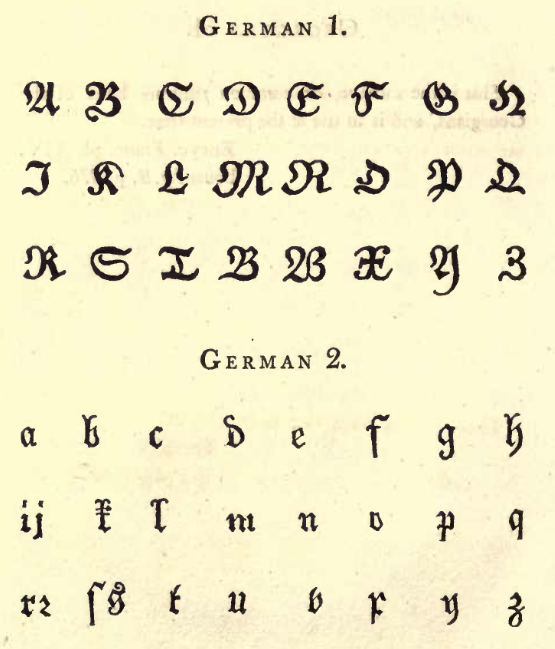
It's spectacular how U reminds ВRU[v] and what is V? and v is like b, x like f! what!?
And N so much similar to R, like what is it even? M is also liket that. seriously, wut
And gothic is even more interesting. The Gothic 1, I don't think I ever saw it.
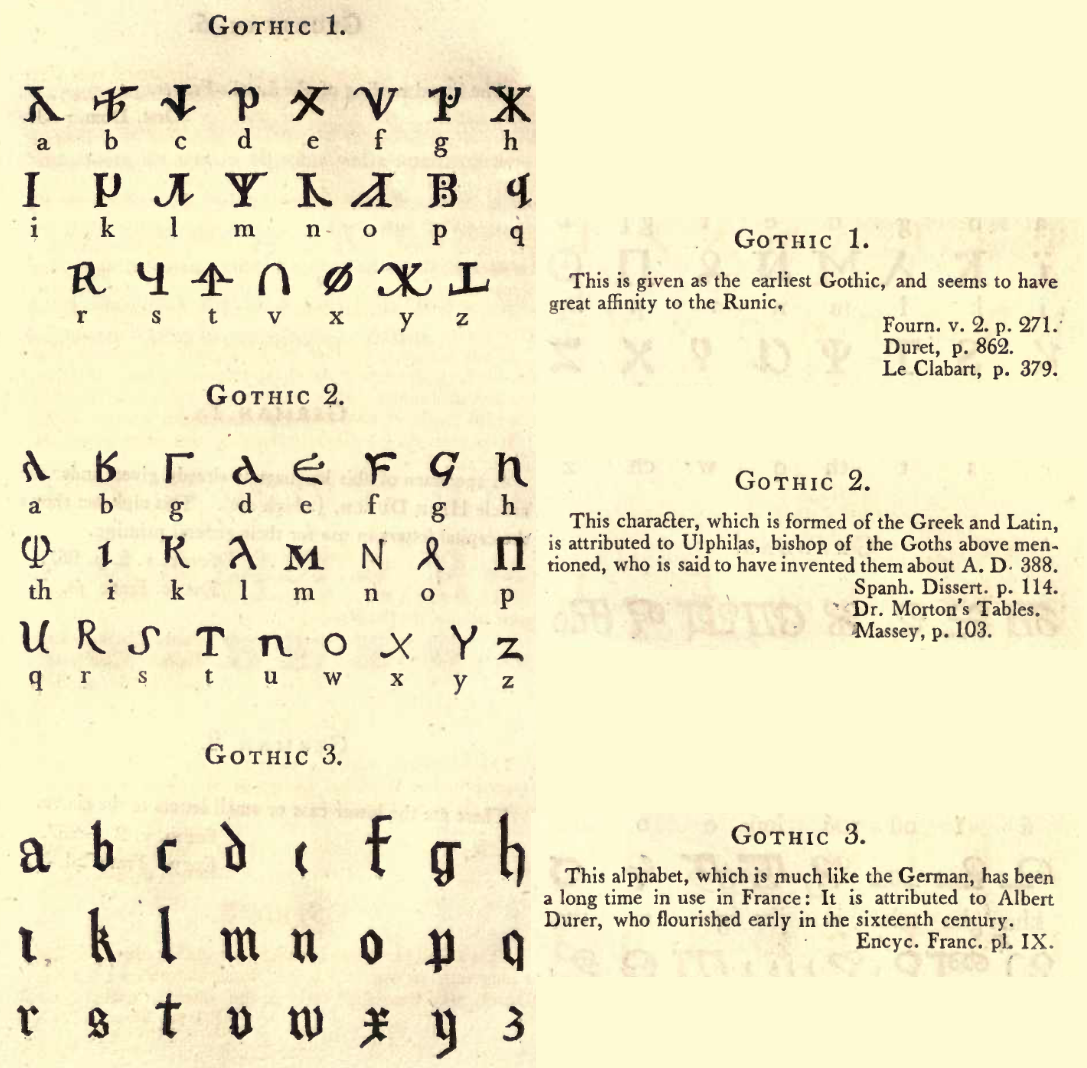
Gothic history literally tells that
"Goths always had the use of letters":
 mirror (the same book
from vol.44)
mirror (the same book
from vol.44)Gothic history literally tells that "Goths always had the use of letters"
are goths gods in that the writing was taken from them, and then they were memory-holed?
The Gothic 1 is the most ancient version of it.
The Gothic 2 is what Ulphila formed around 388AD and yet maybe he did the same thing Mashtots did some centuries later: added some letters. And this one (because we have the previous set to compare, unlike in armenian)
The letters of Gothic 2 seem to be the same letters of Gothic 1, but first obvious change is substitution of 𐰸-like g to Г-like (probably that gothic 𐰸-like rune reminded him of vulva)
In Gothic 1 d looks like p, thus uniting dada and papa.
The e maybe relates to ᛂ, but then see how it transforms first into greek shape and then to some shorter version of c.
strange.
Gothic 1 has f similar to their c the g (notice that what is c in Gothic 1 becomes g in Gothic 2. Two G's Gothic 2 has. Interesting. Or maybe just sloppy work of the linguist. Yet sloppy or not it is impressive and I owe him, I awe him too. ough)
In Gothic 1 f looks like double c in size, not shape. Which may reveal that that c is г, and then the one following f is maybe ж? no, the Ж-like form follows and it's h, the ᚼ. And y has similar forms, just as today h reminds y in shape. y is more flamboyant to this day. Did they remove most of rays? Why? The way they simplified 𒀭 to something as simplistic as this:
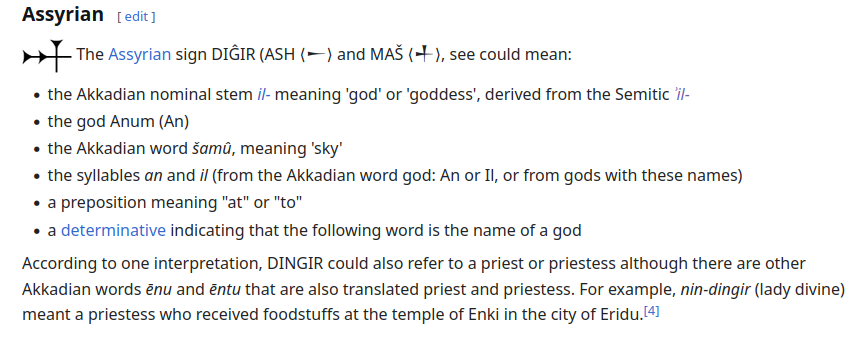
They don't even have that sign in unicode, propably printing 𒀭 instead of it.
and no merged 𒀸𒈦 (DIĜIR
(ASH ⟨𒀸⟩ and MAŠ ⟨𒈦⟩) in the unicode
Back to Gothic:𐌸 Ulphila added some Ψ-like θ at the θ spot. Adding thus the letter. But then both Gothic 1 and Gothic 2 lay into axial symmetry if V the U is vowel and Y is not. Because Ulphila (if it was he and not the goths themselves) also added some weird o-like w (why would he use o for that? and look at his o!)
And gothic 3 does not lay into the axial symmetry either way, unless we consider both u and y consonants, which would be quite a stretch, so no. Whethere it is a coincidence or a demonstration of the period in which the understanding of axial symmetry was lost. If that symmetry even exists and not a peculiar coincidence.

the third line is the unicode, for whatever reason it includes some additional letters. Well, the reasons are obvious: the science didn't stand still. And the double П confused me when I saw it before, like how would they distinguish one from the other? the difference is so subtle, and the other two tables tell that maybe they were not like that. But then, science, man! h
𐌰 𐌱 𐌲 𐌳 𐌴 𐌵 𐌶 𐌷 𐌸 𐌹 𐌺 𐌻 𐌼 𐌽 𐌾
and the rest of them are here: 𐌿 𐍀 𐍁
𐍂 𐍃 𐍄 𐍅 𐍆 𐍇 𐍈 𐍉 𐍊
Some of them are the same, but most of them are rather
different with a third category of somewhat alike: 𐌰, 𐌹, 𐍂 are exactly the same
𐌱, 𐌳, 𐌵, 𐌺, 𐌻, 𐌽, 𐍁, 𐍄, 𐍅 are somewhat alike (𐌵 is for their F which seems as rotated otherwise. Maybe 𐍆 belongs at its place, I wonder why unicode committee placed it in the end. I wonder if their discussions and decissions are archived. They probably were not even filmed, because not many would want to watch it, but now with ai somebody just may)
𐌲, 𐌴, 𐌶, 𐌷, 𐌼, 𐌿, 𐍀, 𐍃, 𐍇/𐍈, the Y, the Z are completely different (though 𐌴 could be in the somewhat alike, since it also can be seen as one line stroke by another) 𐌿 the u is their o for the lack of a better glyph, but then 𐍉 is such glyph, unicode just placed it elsewhere. 𐍀 also can be seen as something alike, but it takes some real imagination.
𐌸 and 𐍈 without a dot are not present in Gothic 1 at all,
𐌾 probably should stand instead of 𐌶.
And maybe 𐍊 belongs somewhere in the 𐍄's place.
the 𐌶 is probably better in the end, instead of 𐍊.
Let's try and toss them over:

and to my surprise they all got into their place perfectly, with only leftovers being the silent numerals they placed their probably for no reason other than some sloppy work of somebody. I have to meet Pitina again, she specializes into Gothic, may want to have a look.
Ѣ-like 𐌱 of Gothic 1 tells that russians could take their Б from there (christian narrative is all lie, I suspect them of being satanist, they lie the most)
Gothic 1's 𐌳 is definitely þ the ᚦ
Gothic 1's 𐍆 looks like ᚠ from some texts, in which it looks like upside down ᚥ with straight lines.
But maybe I
didn't *(couldn't find
an example)
𐌾othic 1's 𐌾 and 𐌷 are directly runes: ᚵᚼ and if not
𐌲, they would repeat the Bornholm's order.As they said, "Great affinity to the Runic"
𐌰 𐌱 𐌲 𐌳 𐌴 𐌵 𐌶 𐌷 𐌸 𐌹 𐌺 𐌻 𐌼 𐌽 𐌾 𐌿 𐍀 𐍁 𐍂 𐍃 𐍄 𐍅 𐍆 𐍇 𐍈 𐍉 𐍊
𐌰 𐌱 𐌲 𐌳 𐌴 𐍆 𐌾 𐌷 𐌸 𐌹 𐌺 𐌻 𐌼 𐌽 𐍉 𐍀 𐌵𐍁 𐍂 𐍃 𐍄𐍊 𐌿 𐍈 𐍇 𐍅 𐌶
ᛅ[j (also a the )] being inverted ᚾ[n] remind me of И[i (й[j])] and N[n]
(but both runes are themselves when diced, they do not invert into one another (unless they throw sticks and see rune in those sticks fallen, and if each stick carries rune, then they may say of what runes that other rune came to be (but then so far it is nothing much but fantasy)))
Old Icelandic rune poem is definitely the original one, because it is nothing else but a set of three kennings:
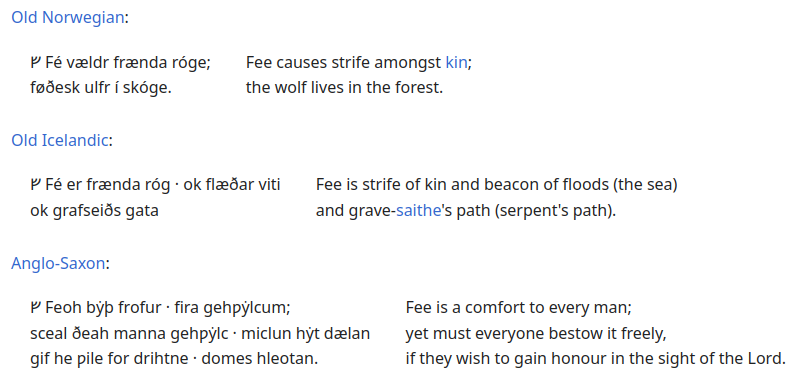
And old Norwegian is just a primer, offering other word as an example:
føðesk seems to be birth in icelandic, according to g.t.
fæðing is the modern term for birth.
Doesn't it remind how f is in the b stpot and that b is for birth?
And Ango-Saxons straighten the meaning up, and thus they succeed.
What a useful book, deus
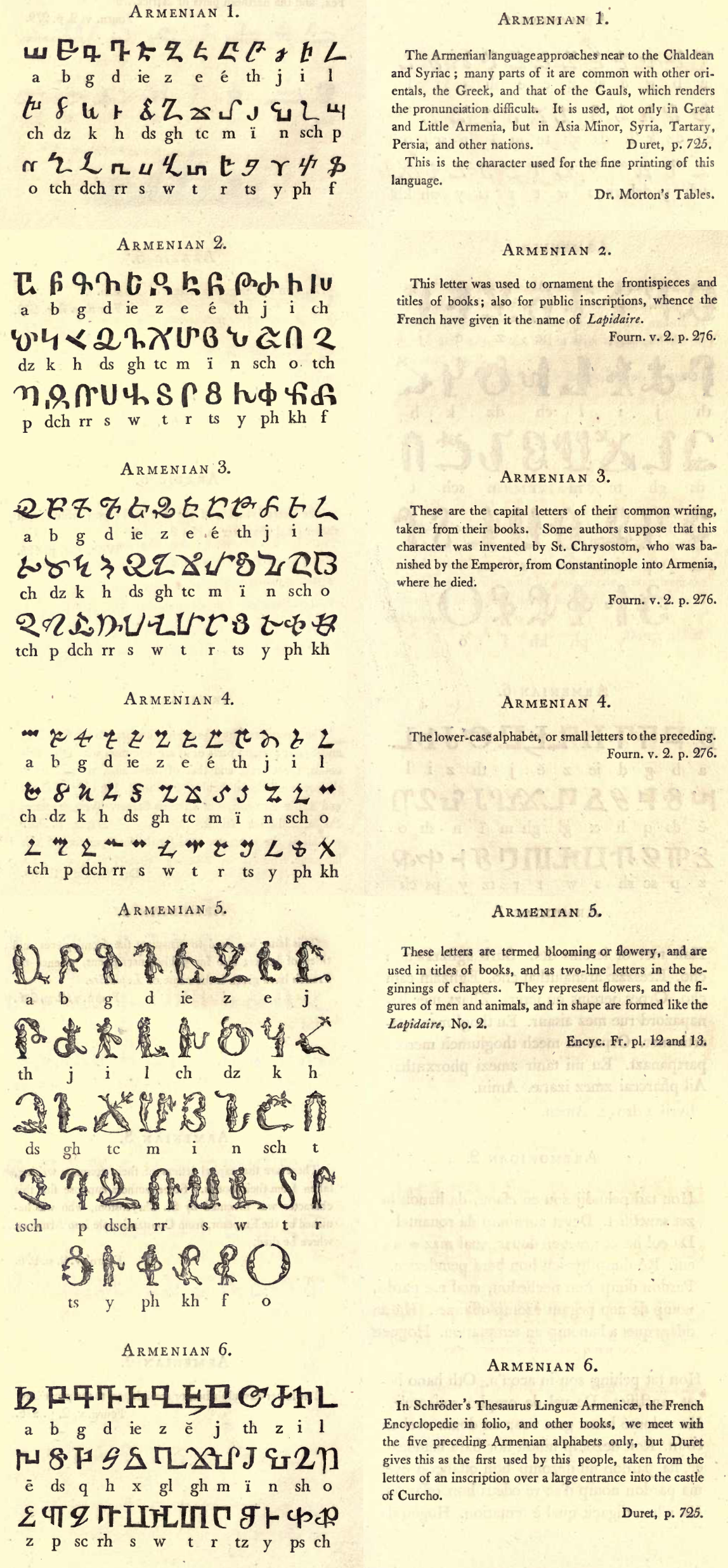
But then do not forget to take it with a grain of salt, because look how much messed up its japanese:
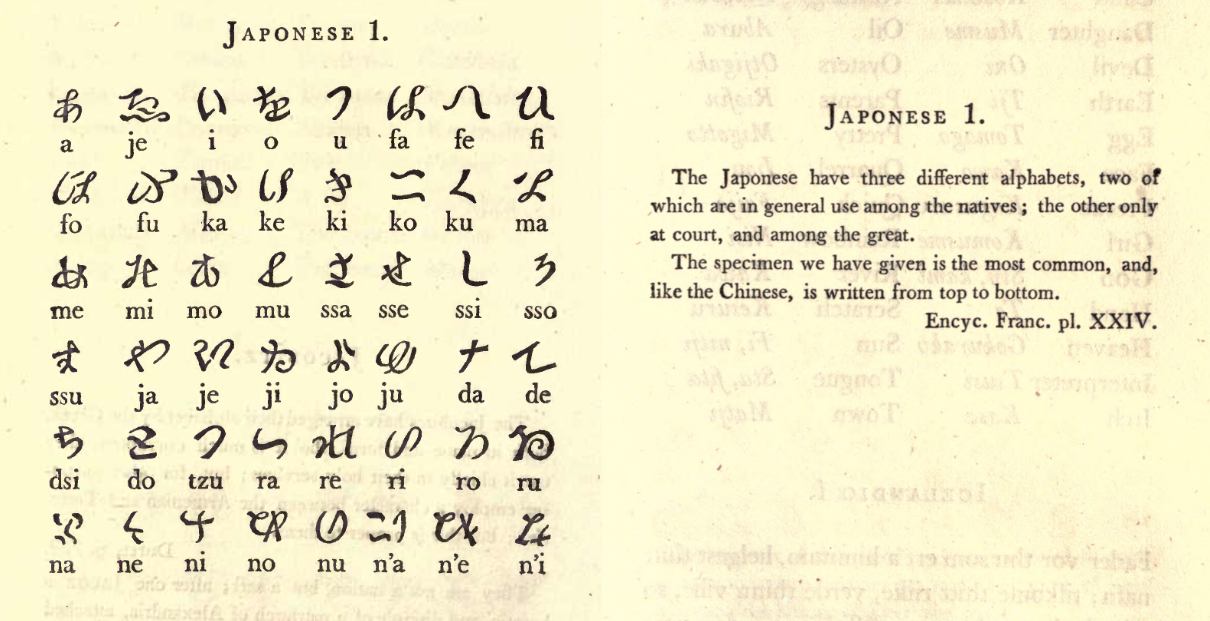
well, at least he wasn't making things up. But how could anybody mess it up so much.
It seems Japan was locked up even then.
Hopefully, Ireland were more open to him: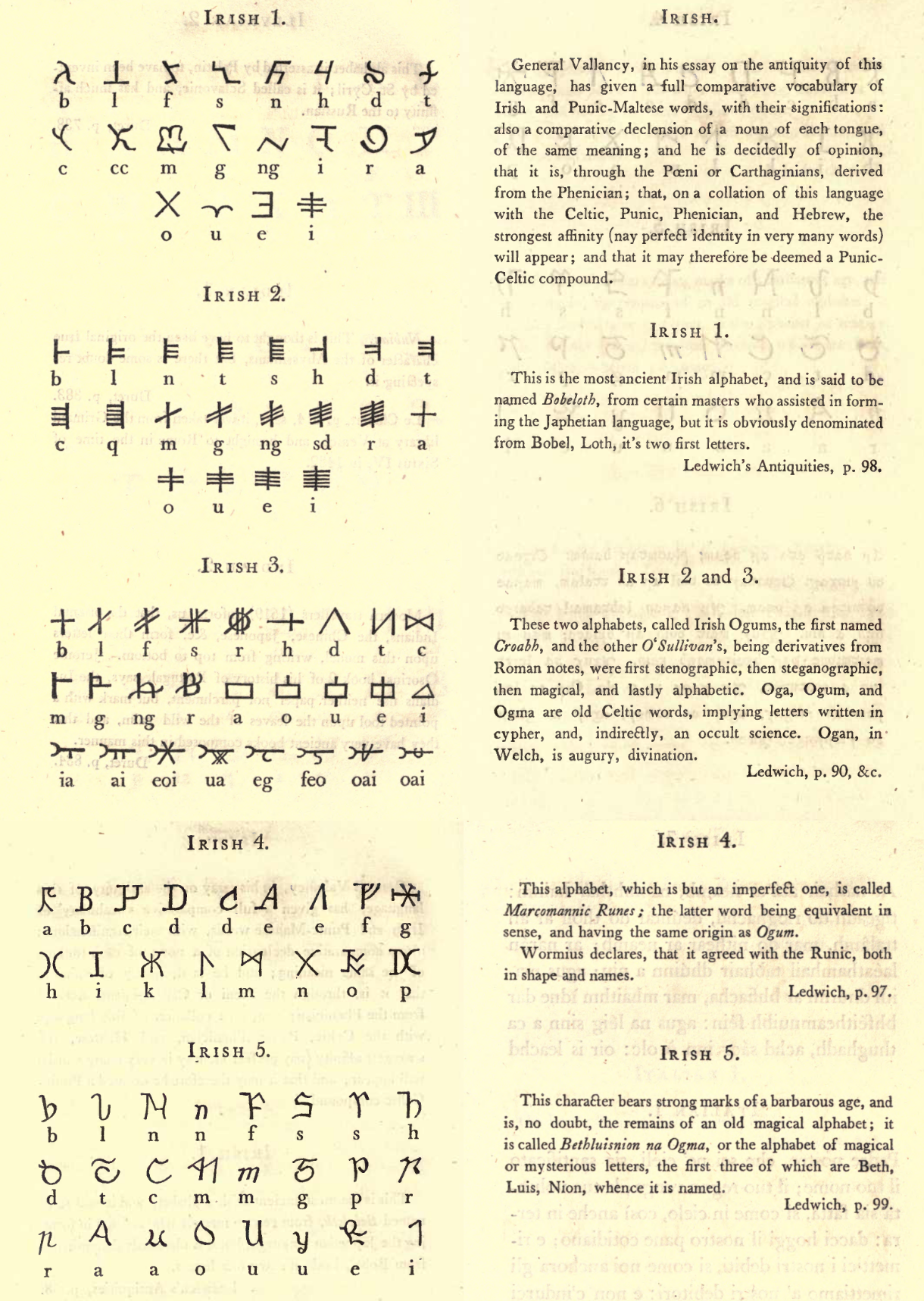
The order of Irish 2 is different from the one I'm used to, and this order goes BLN, as the name tells it to be. And the third is more of the second, while the fifth is more of the fourth alright.
I wonder what made him tell that of Irish 5, since it is the most similar to latin.
and Irish 4 called Marcomannic runes, here is another variant of them:
That q being reversed ch the c.. in Gothic 1 such form stands for s.
This is a inconvenient format making me jump up and down with the scroll. Even paper books are more convenient in that.
I should build something alike to what
Tom Cruise has in Minority Report.
linking images with lines of text. With lines to which text is attached.
linking images with lines of text. With lines to which text is attached.
And another tasty tidbit from that book:
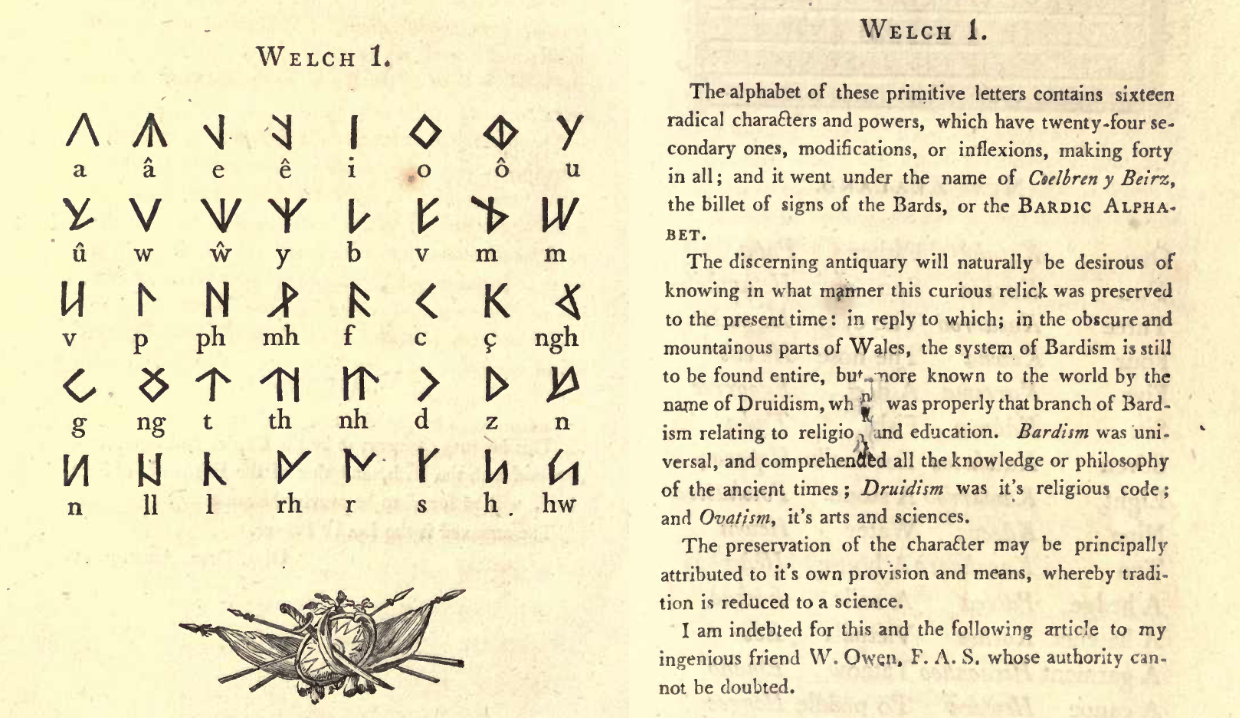
Being of the latest 18th century, the book is full of nonsense, so the egyptian part is and instant mindfuck, only Egyptian 8 is the actual hieroglyphics, without translation or transliteration, of course.
If any of others represent demotic or hieratic, I didn't recognize them at all. I guess they're all garbage.
Yet he doesn't make it up himself, he always mentions the sources.
ulfr ~ wolf ~ волк
úlfur, actually. but then what orthography matters anyway?
Did russians read f as k of German 2?
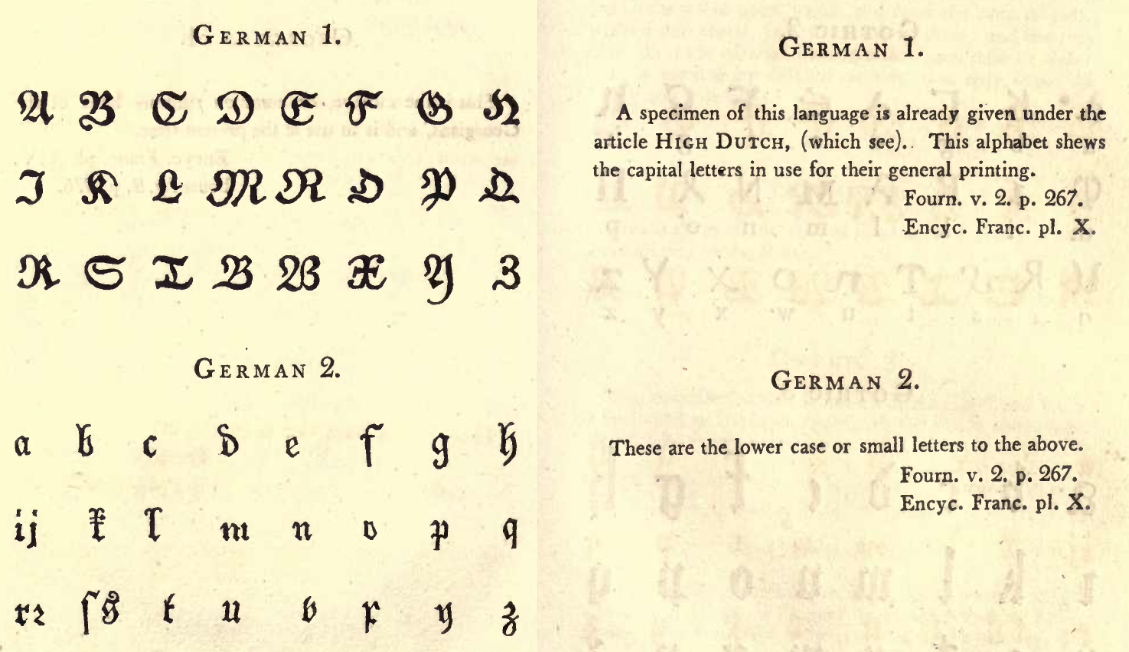
In German 1 B and U are different only in the lower swash of B. Or rather balls at the tips of B, as if they're the two balls of B. Balls!
Balls Cock
is it all?
Balls Cock Dick (no wonder g is both g and д)
A is for Anus, only sodomites could place it like that.
Б is for БоГ
G is for GoD and does it make englishmen closer to India than Russians?
БоГ as Bейца and Гуй?
o ~ ו
GoD as Gogk and Digk?
Not Gog of gog-and-magog, but God
(не gовяный, а добрый? not cheap but
dear? не gуёвый, а дельный)
So I saw Pitina today, and I presented her with the gothic tables, and she said that it's interesting, so I told her to contact me by email if she finds something interesting. But oh gush how poorly I speak!
Good Speech is a skill one has to acquire. I think I should start writing my speeches before I meet the audience. Tomorrow I plan to contact Budeyko, she told me to contact him, again. Why do I still bother her? Well, gothic is her speciality, but she said "если я чё вспомню" посмотрела, сказала интересно, но ей надо было бежать, и я конечно аутист знатный, побежал за ней, пытаясь говорить, но немного поговорил, она похоже тоже аутист. Не знаю, загадка, может она боится что я её разоблачу и нервничает. Или не понимает что мне от неё надо. Но она же функционер, администратор и преподаватель. Они никто там наукой не занимаются как будто. Будейко говорил что преподавательство и лишняя ненужная бумажная работа которой загружают забирают всё время так что на занятие наукой времени не остаётся.
May be they almost ignore me because they know what academia is and wish me well.
But then maybe they see me as a freak. But none of them told me about it, so why make things up.
Because it is
indeed a probability: a man doing science outside of
academia is indeed freekey.
B L N
B Г D
B L N
M L N that contradicts the ImMaNueL part.
It is here to demonstrate how they tell that ᚨ can be F, and that supports that wild hypothesis of futhark being aвþäпqhi..
ᚠᚢᚦᚬᚱᚴ᛬ᚼᚾᛁᛅᛋ᛬ᛐᛒᛘᛚᛦ
ᚨᚢᚦᚬᚱᚴ᛬ᚼᚾᛁᛅᛋ᛬ᛐᛒᛘᛚᛦ
aвþåпк:hnias:tbmly
abcefg: hnias:tbmly
s t sequence closer to the end is yes. but does it tell that there only were two aettir and letters bast t are newer? bmly, could these letters not be in the original set?
let's explore this possibility:
ᚨᚢᚦᚬᚱᚴ᛬ᚼᚾᛁᛅᛋᛐ
aвþ efg :hnia s t
or was it changed for symmetry? could it be
ᚨᚢᚦᚬᚱᚴ᛬ᚼᛁᚾᛅᛋᛐ
and it even can retain the abc structure is ᚾᛅ is M, and could ᛋ be samekh and shin at the same time?
Am I not doing too many assumptions? I'm playing with it, let's play some more:
ᚨᚢᚦ 3 first letter is repuposed on the basis of the Dalecarlian runes and knew it before them.
ᚬᚱᚴ᛬ᚼ 4 second letter is repurposed on the same assumption of alphabetic nature of futhark
ᚾᛁᛅᛋᛐ 5 here I'd have to move the runes around, and it is such a no-no. NIAST?
Just as ᚴᚼ remind GH, so do ᛋᛐ remind ST. It screams alphabet to me. But is it some protoalphabet?
Otherwise why would it be like this.. And there is more. A twenteeth or so argument towards the primate of runic scripts. What the book tells of gothic, yes, but also this:
Ideographic runes:
.jpg)
Part of the Elder Futhark inscription on the Stentoften Runestone in Blekinge, Sweden, assumed to feature an Elder j-rune ᛃ (Proto Norse: jāra, 'yearly harvest') as an ideographic rune.
So that ᛃ is summer and winter,
as if they knew of the excentricity of the planet.
.jpg)
Extracted segment from Fragmentum Runico-Papisticum were the g-rune ᚵ is used as an ideograph for 'God'.
.jpg)
Part of the Elder Futhark inscription on the Stentoften Runestone in Blekinge, Sweden, assumed to feature an Elder j-rune ᛃ (Proto Norse: jāra, 'yearly harvest') as an ideographic rune.
So that ᛃ is summer and winter,
as if they knew of the excentricity of the planet.
.jpg)
Extracted segment from Fragmentum Runico-Papisticum were the g-rune ᚵ is used as an ideograph for 'God'.
ж от жечь в жадность, жлобство?, жопа? жыр. жру. жыр~жор
жар (heat) жарить (to fry) Джа(бог солнца Ра (R is read as Ж in chinese romaji rusiaji))
на жиру? потому что варить значит на воде. во is the root of water, wa,
а что есть да? desu?
е-да(йа-да (йа-вства))
ва-да
пис-да
(писать~сать, означает ли это что с-да is the third element?)
три потребности? чтоб была еда, вода и пиздата (peace)
е-да(йа-да (йа-вства))
ва-да
пис-да
(писать~сать, означает ли это что с-да is the third element?)
три потребности? чтоб была еда, вода и пиздата (peace)
Peace это корень слова писдата
Piss это команда не драться пока
Peas это горошины, это горох
Piece — часть, участок, пьеса, кусок (типа урвал свой и можно не драться)
(и большое количество прочих значений гугл транслейтор отводит ему, а у тех по одному)
барыня-сударыня:
ба(въ) ры(рци(речёт(говорит))) ня(мя(меня))
суда(сюда(here)) ры(рци(речёт(говорит))) ня(мя(меня))
сударь ~ сюда рь (рь от разрешено? мяхкое р тем и отличается от р of запрещено? но там оно тоже мяхкое. в разрешено первое твёрдое как раз. разрешить и разрезать разные же вещи, но все помнят как гордиев узел разрешили: разрезали)
Here's a good part for the "futhark as mistransliterated alphabet":
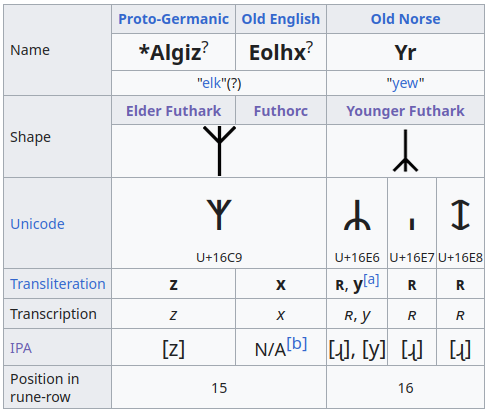
In the context of ᚮᚱᛦᛋᛏᚢ, ᚱ is П!
Thus first aet is ᚨᚢᚦᚮᚱᚴ the aвþ oпк which is abd opq
abd
opq ?
abd
epq would make more sense.
and it makes me wonder if that П the ᚱ could also be F, for it looks similar and it would make fgh sequence, for the next rune, ᚼ is sometimes continues the aet, or it can begin the other one, and then I tend to think it's greek and thus the first letter of the aet is vowel. And also because it is often followed by ᚹ[w]
ᛆᛒᚦᛂ[e](not ᚽ[h])ᚠᚵᚼ[h](or ᛡ[й, а (e(ᛂ)?)])ᛁᚴᛚᛘ[m](not ᛉ[z, ks])ᚿᚮᚱᛦ[(y)r](or ᛣ[q])ᛋᛏᚢ bornholm runes
ᚠᚡᚢᚣᚤᚥᚦᚧᚨᚩᚪᚫᚬᚭᚮᚯᚰᚱᚲᚳᚴᚵᚶᚷᚸᚹᚺᚻᚼᚽᚾᚿᛀᛁᛂᛃᛄᛅᛆᛇᛈᛉᛊᛋᛌᛍᛎᛏᛐᛑᛒᛓᛔᛕᛖᛗᛘᛙᛚᛛᛜᛝᛞᛟᛠᛡᛢᛣᛤᛥᛦᛧᛨᛩᛪ᛫᛬᛭ᛮᛯᛰᛱᛲᛳᛴᛵᛶᛷᛸ
ᚠᚢᚦᚨᚱᚲᚷᚹ᛬ ᚺᚾᛁᛃᛇᛈᛉᛊ᛬ ᛏᛒᛖᛗᛚᛜᛞᛟ: elder fuþark (1(?)c.~9c.) gothic runes are the same plus quairtra(𐍁)
ᚠᚢᚦᚩᚱᚳᚷᚹ ᚻᚾᛁᛄᛇᛈᛉᛋ ᛏᛒᛖᛗᛚᛝᛞᛟ ᚪᚫᚣᛠ: anglo-frisian (5c.~9c.)
ᚠᚢᚦᚩᚱᚳᚷᚹ ᚻᚾᛁᛄᛇᛈᛉᛋ ᛏᛒᛖᛗᛚᛝᛞᛟ ᚪᚫᚣᛡᛠᛣᛤᚸ 'ᛢᛥ: anglo-frisian (?, the same set as in the next)
ᚠᚢᚦᚩᚱᚳᚷᚹ ᚻᚾᛁᛄᛇᛈᛉᛋ ᛏᛒᛖᛗᛚᛝᛞᛟ ᚪᚫᚣ ᛠ ᛡᚸᛣᛢᛥᛤ: later anglo-saxon futhorc (8c.~12c.)
(short-twig)ᚠᚢᚦᚭᚱᚴ᛬ᚽᚿᛁᛆᛌ᛬ᛐᛓᛙᛚᛧ: younger fuþark (8c.~11c.) ᚠᚢᚦᚬᚱᚴ᛬ᚼᚾᛁᛅᛋ᛬ᛏᛒᛘᛚᛦ(long-twig)
ᚠᚢᚦᚬᚱᚴ᛬ᚼᚾᛁᛅᛋ᛬ᛐᛒᛘᛚᛦ later younger fuþark (11c~13c.) ᚡv ᚤy,ö ᚧð ᚵg,ng ᛀN ᛂe,ä ᛑd ᛔp ᛛL
ᚠᚢᚦᚮᚱᚴ᛬ᚼᚿᛁᛆᛋ᛬ᛐᛒᛘᛚᛦmedieval fuþark(13~16c)ᚡv ᚤy,v ᚧð ᚰǫ,å ᚵg ᚶng ᛀn ᛀN ᛂe ᛅä ᛍc ᛎz ᛑd ᛔp ᛕp ᛛL
ᚼᚿᛁᛆᛋ
or ᚻᚾᛁᛄᛇᛈᛉᛋ make the second aet. and both ᚼ and ᚻ are for h, so some doubling happened here, and thus Younger futhark might be actually the younger form of the writing system (more ancient form, in spite of what it is taught to be)
But now so called Older Futhark is closer to the alphabeti structure: ᚻᚾᛁᛄᛇᛈᛉᛋ [hnijïpzs]
(let's guess h and n were added as a doubling of the ᚷᚹ, then we get a large vowel claster followed by labial and linguals, as they do in alphabets. But to be honest ᛉ is not only z, but also x, r, y; so it's xyz at the same time? some transliterations are probably wrong; and ᛇ is not only iː, but also x and ç, yet as the coloured table at the next screen shows it makes it k. but ᛈ is p, not m, but ᛈᛉᛊᛏ is so much πρςτ, yet why would they flip. I'm speaking from the perspective of the coloured futhark a screen later.
ᛖᛗᛚᛜᛞᛟ of the third aet is emlŋdo, что невероятно близко к имлнΞо
so, let's wrap it up:
ᚨᚢᚦ
ᚨᚱᚲᚷᚹ᛬ ᚺᚾ
ᛁᛃᛇᛈᛉᛊ᛬ ᛏᛒ
ᛖᛗᛚᛜᛞᛟ
something like that could we have?
something of the kind:
ᚨᚢᚦ
ᚩᚱᚲᚷᚹ᛬ ᚺᚾ
ᛁᛃᛇᛈᛉᛊ᛬ ᛏᛒ
ᛖᛗᛚᛜᛞᛟ
Basically all I had to do is to retransliterate ᚠ as ᚨ, on the basis of the delacarlian dalecarlian runes
and then to retransliterate ᚱ as П on the basis of borhnolom's abecedary.
And then what do I make of ᚷᚹ? which of them do I ignore? It would be another line if ᚷ was vowel, but all they offer for it are [ɣ], [g], [ɣ], [ʎ], [j], [g] so let's not ignore it as if it's nothing.
But then I know from armenian that runes are being used here and there from time to time.
ᛒ being post T may make it a later addition, and maybe all the ᛖᛗᛚᛜᛞᛟ is a later addition (even though it is a perfect vowel-labial-linguals. More than that, it goes MLN, eMLN?o, but then it may tell that sonors are something as new as N is for new. It is our best line and I'm about to cut it off?
If ᛁᛃᛇᛈᛉᛊᛏ is the
Let's look at Younger futhark:
ᚨᚢᚦ
ᚮᚱᚴ᛬ᚼᚿ
ᛁᛆᛋ᛬ᛐ ᛆ is not only a, but also j. Right after i.
ᛒᛘᛚᛦ [b m l r] could they be a later addition? could they be L right left to R?
If a and b switched places it would be a closed case, but why would they, so it's not. Still a hypothesis.
but then again, if I didn't retransliterate them, they would look like this:
ᚠᚢᚦ or even ᚠᚢᚦ
ᚮᚱᚴ᛬ᚼᚿ
ᛁᛆᛋ᛬ᛐ
ᛒᛘᛚᛦ
whis isway less impressive, though it has some perk quirk to it.
the way labials and vowels tend to be grouped by two tells that they're likely clasters.
such a jungle this thing is.
that ᚠᚢᚦ made me wonder if they're actually ᛓᚢᚦ the three norns ᛓerdandi ᚢrd & ᚦkuld?
So is that ᚠ ᚨ or ᛓ? The honest ansdwer is I still don't know. Could be both, could be none of them, but what interests me now is if ᚨ and ᛓ reflect eachother the way a and б do.
and also if ᚨ and ᛚ are like Α and Λ (now that is more like it, neh?) and then is ᛓ crossed V or something? like earth? But Λ for fire is not exactly right, even with Л in flame and пламя, those have labials before that L, which really makes me wonder if that word actually refers to water. Типа полей, затуши. Yet A is great for Air.
полей (water (as a verb)) and полей (of fields)
если луга то заливные.
and for whatever reason this volume decided to go down like it starts to lag hard and all of the sudden.
so here we switch to vol. 48
and let's not explain that silly reason anymore
.
